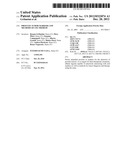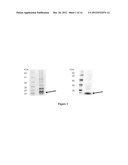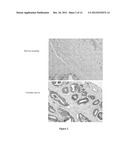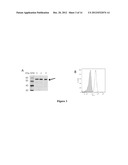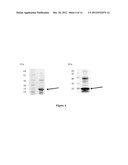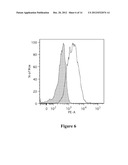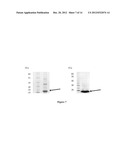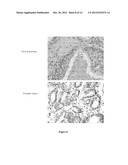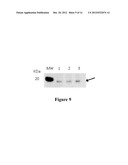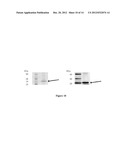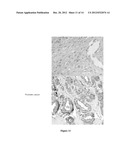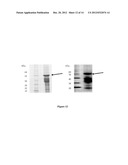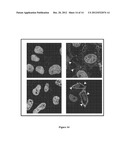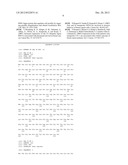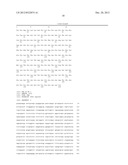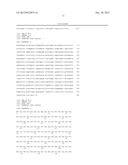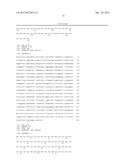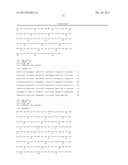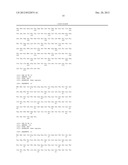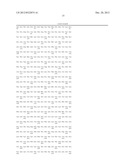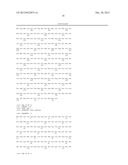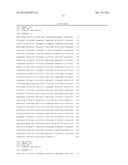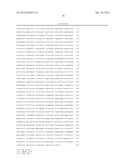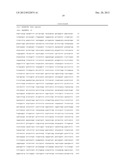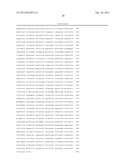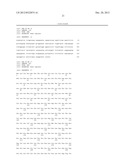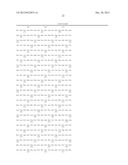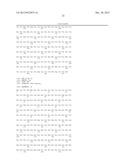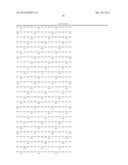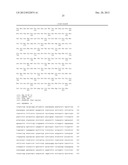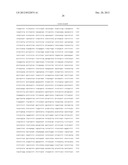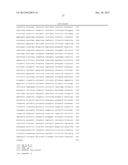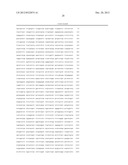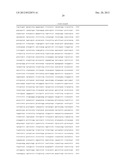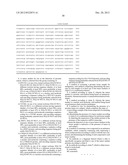Patent application title: Prostate Tumor Markers and Methods of Use Thereof
Inventors:
Renata Grifantini (Siena, IT)
Renata Grifantini (Siena, IT)
Piero Pileri (Siena, IT)
Piero Pileri (Siena, IT)
Susanna Campagnoli (Siena, IT)
Susanna Campagnoli (Siena, IT)
Alberto Grandi (Siena, IT)
Alberto Grandi (Siena, IT)
Matteo Parri (Siena, IT)
Matteo Parri (Siena, IT)
Andrea Pierleoni (Siena, IT)
Renzo Nogarotto (Siena, IT)
Assignees:
EXTERNAUTICS S.P.A.,
IPC8 Class: AG01N33574FI
USPC Class:
435 612
Class name: Measuring or testing process involving enzymes or micro-organisms; composition or test strip therefore; processes of forming such composition or test strip involving nucleic acid with significant amplification step (e.g., polymerase chain reaction (pcr), etc.)
Publication date: 2012-12-20
Patent application number: 20120322074
Abstract:
Newly identified proteins as markers for the detection of prostate
tumors, or as targets for their therapeutic treatment, affinity ligands
capable of selectively interacting with said markers as well as methods
for tumor diagnosis and therapy using the same.Claims:
1. A tumor marker for use in the detection of prostate cancer, which is
selected from the group consisting of: i) DPY19L3, in one of its variant
isoforms SEQ ID NO:9, SEQ ID NO:10, SEQ ID NO:11, SEQ ID NO:12, or a
different isoform having sequence identity of at least 80%, preferably at
least 90%, more preferably at least 95% to any of SEQ ID NO:9, SEQ ID
NO:10, SEQ ID NO:11 or SEQ ID NO:12, or a nucleic acid molecule
containing a sequence coding for a DPY19L3 protein, said encoding
sequence being preferably selected from SEQ ID NO:13, SEQ ID NO:14, SEQ
ID NO:15 and SEQ ID NO:16; ii) VSTM1, in one of its variant isoforms SEQ
ID NO:1, SEQ ID NO:2, or a different isoform having sequence identity of
at least 80%, preferably at least 90%, more preferably at least 95% to
SEQ ID NO:1 or SEQ ID NO:2, or a nucleic acid molecule containing a
sequence coding for a VSTM1 protein, said encoding sequence being
preferably selected from SEQ ID NO:3 and SEQ ID NO:4; iii) RNF5, SEQ ID
NO:5, or a different isoform having sequence identity of at least 80%,
preferably at least 90%, more preferably at least 95% to SEQ ID NO:5, or
a nucleic acid molecule containing a sequence coding for a RNF5 protein,
said encoding sequence being preferably SEQ ID NO: 6; iv) UNQ6126, SEQ ID
NO:7, or a different isoform having sequence identity of at least 80%,
preferably at least 90%, more preferably at least 95% to SEQ ID NO:7, or
a nucleic acid molecule containing a sequence coding for a UNQ6126
protein, said encoding sequence being preferably SEQ ID NO: 8; v)
SLC39A10, in one of its variant isoforms SEQ ID NO:17, SEQ ID NO:18 or a
different isoform having sequence identity of at least 80%, preferably at
least 90%, more preferably at least 95% to SEQ ID NO:17 or SEQ ID NO:18,
or a nucleic acid molecule containing a sequence coding for a SLC39A10
protein, said encoding sequence being preferably selected from SEQ ID
NO:19 and SEQ ID NO:20.
2. A method of screening a prostate tissue sample for malignancy, said method comprising determining the presence in said sample of at least one of the tumor markers of claim 1 or a combination thereof.
3. A method according to claim 2, wherein the tumor marker is a protein, said method being based on immunoradiometric, immunoenzymatic or immunohistochemical techniques.
4. A method according to claim 2, wherein the tumor marker is a nucleic acid molecule, said method being based on polymerase chain reaction techniques.
5. A method in vitro for determining the presence of a prostate tumor in a subject, which comprises the steps of: (a) providing a sample of the tissue suspected of containing tumor cells; (b) determining the presence of a tumor marker according to claim 1 or a combination thereof in said tissue sample by detecting the expression of the marker protein or the presence of the respective mRNA transcript; wherein the detection of one or more tumor markers in the tissue sample is indicative of the presence of tumor in said subject.
6. A method of screening a test compound as an antitumor candidate, which comprises contacting cells expressing a tumor marker protein according to claim 1 with the test compound, and determining the binding of said compound to said tumor marker.
7. An antibody or a fragment thereof which is able to specifically recognize and bind to one of the tumor marker proteins according to claim 1.
8. An antibody according to claim 7, which is either monoclonal or polyclonal.
9. (canceled)
10. (canceled)
Description:
[0001] The present invention relates to newly identified proteins as
markers for the detection of prostate tumors, or as targets for their
treatment. Also provided are affinity ligands capable of selectively
interacting with the newly identified markers as well as methods for
tumor diagnosis and therapy using the same.
BACKGROUND OF THE INVENTION
[0002] Tumor Markers (or Biomarkers)
[0003] Tumor markers are substances that can be produced by tumor cells or by other cells of the body in response to cancer. In particular, a protein biomarker is either a single protein or a panel of different proteins, that could be used to unambiguously distinguish a disease state. Ideally, a biomarker would have both a high specificity and sensitivity, being represented in a significant percentage of the cases of given disease and not in healthy state.
[0004] Biomarkers can be identified in different biological samples, like tissue biopsies or preferably biological fluids (saliva, urine, blood-derivatives and other body fluids), whose collection does not necessitate invasive treatments. Tumor marker levels may be categorized in three major classes on the basis of their clinical use. Diagnostic markers can be used in the detection and diagnosis of cancer. Prognostics markers are indicative of specific outcomes of the disease and can be used to define predictive models that allow the clinicians to predict the likely prognosis of the disease at time of diagnosis. Moreover, prognosis markers are helpful to monitor the patient response to a drug therapy and facilitate a more personalized patient management. A decrease or return to a normal level may indicate that the cancer is responding to therapy, whereas an increase may indicate that the cancer is not responding. After treatment has ended, tumor marker levels may be used to check for recurrence of the tumor. Finally, therapeutic markers can be used to develop tumor-specific drugs or affinity ligand (i.e. antibodies) for a prophylactic intervention.
[0005] Currently, although an abnormal tumor marker level may suggest cancer, this alone is usually not enough to accurately diagnose cancer and their measurement in body fluids is frequently combined with other tests, such as a biopsy and radioscopic examination. Frequently, tumor marker levels are not altered in all of people with a certain cancer disease, especially if the cancer is at early stage. Some tumor marker levels can also be altered in patients with noncancerous conditions. Most biomarkers commonly used in clinical practice do not reach a sufficiently high level of specificity and sensitivity to unambiguously distinguish a tumor from a normal state.
[0006] To date the number of markers that are expressed abnormally is limited to certain types/subtypes of cancer, some of which are also found in other diseases. (http://www.cancer.gov/cancertopics/factsheet).
[0007] For instance, the human epidermal growth factor receptor (HER2) is a marker protein overproduced in about 20% of breast cancers, whose expression is typically associated with a more aggressive and recurrent tumors of this class.
[0008] Routine Screening Test for Tumor Diagnosis
[0009] Screening tests are a way of detecting cancer early, before there are any symptoms. For a screening test to be helpful, it should have high sensitivity and specificity. Sensitivity refers to the test's ability to identify people who have the disease. Specificity refers to the test's ability to identify people who do not have the disease. Different molecular biology approaches such as analysis of DNA sequencing, small nucleotide polymorphyms, in situ hybridization and whole transcriptional profile analysis have done remarkable progresses to discriminate a tumor state from a normal state and are accelerating the knowledge process in the tumor field. However so far different reasons are delaying their use in the common clinical practice, including the higher analysis complexity and their expensiveness. Other diagnosis tools whose application is increasing in clinics include in situ hybridization and gene sequencing.
[0010] Currently, Immuno-HistoChemistry (IHC), a technique that allows the detection of proteins expressed in tissues and cells using specific antibodies, is the most commonly used method for the clinical diagnosis of tumor samples. This technique enables the analysis of cell morphology and the classification of tissue samples on the basis of their immunoreactivity. However, at present, IHC can be used in clinical practice to detect cancerous cells of tumor types for which protein markers and specific antibodies are available. In this context, the identification of a large panel of markers for the most frequent cancer classes would have a great impact in the clinical diagnosis of the disease.
[0011] Anti-Cancer Therapies
[0012] In the last decades, an overwhelming number of studies remarkably contributed to the comprehension of the molecular mechanisms leading to cancer. However, this scientific progress in the molecular oncology field has not been paralleled by a comparable progress in cancer diagnosis and therapy. Surgery and/or radiotherapy are the still the main modality of local treatment of cancer in the majority of patients. However, these treatments are effective only at initial phases of the disease and in particular for solid tumors of epithelial origin, as is the case of colon, lung, breast, prostate and others, while they are not effective for distant recurrence of the disease. In some tumor classes, chemotherapy treatments have been developed, which generally relies on drugs, hormones and antibodies, targeting specific biological processes used by cancers to grow and spread. However, so far many cancer therapies had limited efficacy due to severity of side effects and overall toxicity. Indeed, a major effort in cancer therapy is the development of treatments able to target specifically tumor cells causing limited damages to surrounding normal cells thereby decreasing adverse side effects. Recent developments in cancer therapy in this direction are encouraging, indicating that in some cases a cancer specific therapy is feasible. In particular, the development and commercialization of humanized monoclonal antibodies that recognize specifically tumor-associated markers and promote the elimination of cancer is one of the most promising solutions that appears to be an extremely favorable market opportunity for pharmaceutical companies. However, at present the number of therapeutic antibodies available on the market or under clinical studies is very limited and restricted to specific cancer classes. So far licensed monoclonal antibodies currently used in clinics for the therapy of specific tumor classes, show only a partial efficacy and are frequently associated with chemotherapies to increase their therapeutic effect.
[0013] Administration of Trastuzumab (Herceptin), a commercial monoclonal antibody targeting HER2, a protein overproduced in about 20% of breast cancers, in conjunction with Taxol adjuvant chemotherapy induces tumor remission in about 42% of the cases. Bevacizumab (Avastin) and Cetuximab (Erbitux) are two monoclonal antibodies recently licensed for use in humans, targeting the endothelial and epithelial growth factors respectively that, combined with adjuvant chemotherapy, proved to be effective against different tumor diseases. Bevacizumab proved to be effective in prolonging the life of patients with metastatic colorectal, breast and lung cancers. Cetuximab demostrated efficacy in patients with tumor types refractory to standard chemotherapeutic treatments (Adams G. P. and Weiner L. M. (2005) Monoclonal antibody therapy cancer. Nat. Biotechnol. 23:1147-57).
[0014] In summary, available screening tests for tumor diagnosis are uncomfortable or invasive and this sometimes limits their applications. Moreover tumor markers available today have a limited utility in clinics due to either their incapability to detect all tumor subtypes of the defined cancers types and/or to distinguish unambiguously tumor vs. normal tissues. Similarly, licensed monoclonal antibodies combined with standard chemotherapies are not effective against the majority of cases. Therefore, there is a great demand for new tools to advance the diagnosis and treatment of cancer.
[0015] Experimental Approaches Commonly Used to Identify Tumor Markers
[0016] Most popular approaches used to discover new tumor markers are based on genome-wide transcription profile or total protein content analyses of tumor. These studies usually lead to the identification of groups of mRNAs and proteins which are differentially expressed in tumors. Validation experiments then follow to eventually single out, among the hundreds of RNAs/proteins identified, the very few that have the potential to become useful markers. Although often successful, these approaches have several limitations and often, do not provide firm indications on the association of protein markers with tumor. A first limitation is that, since frequently mRNA levels not always correlate with corresponding protein abundance (approx. 50% correlation), studies based on transcription profile do not provide solid information regarding the expression of protein markers in tumor. (1, 2, 3, 4).
[0017] A second limitation is that neither transcription profiles nor analysis of total protein content discriminate post-translation modifications, which often occur during oncogenesis. These modifications, including phosphorylations, acetylations, and glycosylations, or protein cleavages influence significantly protein stability, localization, interactions, and functions (5).
[0018] As a consequence, large scale studies generally result in long lists of differentially expressed genes that would require complex experimental paths in order to validate the potential markers. However, large scale genomic/proteomic studies reporting novel tumor markers frequently lack of confirmation data on the reported potential novel markers and thus do not provide solid demonstration on the association of the described protein markers with tumor.
[0019] The approach that we used to identify the protein markers included in the present invention is based on an innovative immuno-proteomic technology. In essence, a library of recombinant human proteins has been produced from E. coli and is being used to generate polyclonal antibodies against each of the recombinant proteins.
[0020] The screening of the antibodies library on Tissue microarrays (TMAs) carrying clinical samples from different patients affected by the tumor under investigation lead to the identification of specific tumor marker proteins. Therefore, by screening TMAs with the antibody library, the tumor markers are visualized by immuno-histochemistry, the classical technology applied in all clinical pathology laboratories. Since TMAs also include healthy tissues, the specificity of the antibodies for the tumors can be immediately appreciated and information on the relative level of expression and cellular localization of the markers can be obtained. In our approach the markers are subjected to a validation process consisting in a molecular and cellular characterization.
[0021] Altogether, the detection the marker proteins disclosed in the present invention selectively in tumor samples and the subsequent validation experiments lead to an unambiguous confirmation of the marker identity and confirm its association with defined tumor classes. Moreover this process provides an indication of the possible use of the proteins as tools for diagnostic or therapeutic intervention. For instance, markers showing a surface cellular localization could be both diagnostic and therapeutic markers against which both chemical and antibody therapies can be developed. Differently, markers showing a cytoplasmic expression could be more likely considered for the development of tumor diagnostic tests and chemotherapy/small molecules treatments.
SUMMARY OF THE INVENTION
[0022] The present invention provides new means for the detection and treatment of prostate tumors, based on the identification of protein markers specific for these tumor types, namely:
[0023] i) Dpy-19-like 3 (DPY19L3);
[0024] ii) V-set and transmembrane domain containing 1 (VSTM1);
[0025] iii) Ring Finger protein 5 (RNF5);
[0026] iv) Uncharacterized protein UNQ6126/PRO20091 (UNQ6126);
[0027] v) Solute carrier family 39 (zinc transporter), member 10 (SLC39A10).
[0028] In one embodiment, the invention provides the use of DPY19L3, VSTM1, RNF5, UNQ6126, SLC39A10, as markers or targets for prostate tumor.
[0029] The invention also provides a method for the diagnosis of these cancer types, comprising a step of detecting the above-identified markers in a biological sample, e.g. in a tissue sample of a subject suspected of having or at risk of developing malignancies or susceptible to cancer recurrences.
[0030] In addition, the tumor markers identify novel targets for affinity ligands which can be used for therapeutic applications. Also provided are affinity ligands, particularly antibodies, capable of selectively interacting with the newly identified protein markers.
DETAILED DISCLOSURE OF THE INVENTION
[0031] The present invention is based on the surprising finding of antibodies that are able to specifically stain prostate tumor tissues from patients, while negative or very poor staining is observed in normal prostate tissues from the same patients. These antibodies have been found to specifically bind to proteins for which no previous association with tumor has been reported. Hence, in a first aspect, the invention provides a ovarian tumor marker which is selected from the group consisting of:
[0032] i) VSTM1, in one of its variant isoforms SEQ ID NO:1, SEQ ID NO:2, or a different isoform having sequence identity of at least 80%, preferably at least 90%, more preferably at least 95% to SEQ ID NO:1 or SEQ ID NO:2, or a nucleic acid molecule containing a sequence coding for a VSTM1 protein, said encoding sequence being preferably selected from SEQ ID NO:3 and SEQ ID NO:4;
[0033] ii) RNF5, SEQ ID NO:5, or a different isoform having sequence identity of at least 80%, preferably at least 90%, more preferably at least 95% to SEQ ID NO:5, or a nucleic acid molecule containing a sequence coding for a RNF5 protein, said encoding sequence being preferably SEQ ID NO: 6;
[0034] iii) UNQ6126, SEQ ID NO:7, or a different isoform having sequence identity of at least 80%, preferably at least 90%, more preferably at least 95% to SEQ ID NO:7, or a nucleic acid molecule containing a sequence coding for a UNQ6126 protein, said encoding sequence being preferably SEQ ID NO: 8;
[0035] iv) DPY19L3, in one of its variant isoforms SEQ ID NO:9, SEQ ID NO:10, SEQ ID NO:11, SEQ ID NO:12, or a different isoform having sequence identity of at least 80%, preferably at least 90%, more preferably at least 95% to any of SEQ ID NO:9, SEQ ID NO:10, SEQ ID NO:11 or SEQ ID NO:12, or a nucleic acid molecule containing a sequence coding for a DPY19L3 protein, said encoding sequence being preferably selected from SEQ ID NO:13, SEQ ID NO:14, SEQ ID NO:15 and SEQ ID NO:16;
[0036] v) SLC39A10, in one of its variant isoforms SEQ ID NO:17, SEQ ID NO:18 or a different isoform having sequence identity of at least 80%, preferably at least 90%, more preferably at least 95% to SEQ ID NO:17 or SEQ ID NO:18, or a nucleic acid molecule containing a sequence coding for a SLC39A10 protein, said encoding sequence being preferably selected from SEQ ID NO:19 and SEQ ID NO:20.
[0037] As used herein, "Percent (%) amino acid sequence identity" with respect to the marker protein sequences identified herein indicates the percentage of amino acid residues in a full-length protein variant or isoform according to the invention, or in a portion thereof, that are identical with the amino acid residues in the specific marker sequence, after aligning the sequences and introducing gaps, if necessary, to achieve the maximum percent sequence identity, and not considering any conservative substitutions as part of the sequence identity. Alignment for purposes of determining percent amino acid sequence identity can be achieved in various ways that are within the skill in the art, for instance, using publicly available computer software such as BLAST, BLAST-2, ALIGN or Megalign (DNASTAR) software. Those skilled in the art can determine appropriate parameters for measuring alignment, including any algorithms needed to achieve maximal alignment over the full length of the sequences being compared. Identity between nucleotide sequences is preferably determined by the Smith-Waterman homology search algorithm as implemented in the MPSRCH program (Oxford Molecular), using an affine gap search with parameters gap open penalty=12 and gap extension penalty=1.
[0038] V-set and transmembrane domain containing 1 (VSTM1; Gene ID: ENSG00000189068; Transcript ID: ENST00000338372, ENST00000376626; Protein ID: ENSP00000343366, ENSP00000365813); is an uncharacterized protein without previous known association with tumor and is preferably used as a marker for prostate tumor, and in general for cancers of this type. As described below, an antibody generated towards VSTM1 protein shows a selective immunoreactivity in histological preparation of prostate cancer tissues which indicates the presence of this protein in these cancer samples. Moreover the protein was detected on the surface of tumor cell lines by the specific antibody, suggesting that it can be exploited as target for affinity ligands with therapeutic activity.
[0039] Ring finger protein 5 (RNF5; synonyms: E3 ubiquitin-protein ligase RNF5, HsRma1, Protein G16; Gene ID: ENSG00000183574; Transcript ID ENST00000383289; Protein ID: ENSP00000372776) The protein encoded by this gene contains a RING finger, which is a motif known to be involved in protein-protein interactions. This protein is a membrane-bound ubiquitin ligase. Silencing of RNF5 gene suggested that it can regulate cell motility by targeting paxillin ubiquitination and altering the distribution and localization of paxillin in cytoplasm and cell focal adhesions (6). RNF5 expression has also been reported in some tumor types, but most studies are limited to the detection of RNF5 mRNA and lack of confirmatory data at protein level. Microarray analysis revealed that RNF5 transcription is upregulated in carcinomas from breast, colon, esophagous, and lung. In these studies, expression of RNF5 in tumor has been confirmed at protein level on breast and melanoma tumor tissues, while no data are available on the other tumor classes (7). RNF5 mRNA has also been mentioned in patent/patent applications based on global transcription profile of prostate cancer (eg. U.S. Pat. No. 7,229,774 B2). However, no data have been reported documenting the association of RNF5 protein in prostate tumor tissues. Therefore, we disclose RNF5 as a protein without previous known association with prostate tumor and is preferably used as a marker for prostate tumor and in general for these cancer types. As described below, an antibody generated towards RNF5 protein shows a selective immunoreactivity in histological preparation of prostate cancer tissues, which indicates the presence of this protein in these cancer samples. Moreover the protein is detected on a panel of prostate tumor cell lines reinforcing the evidence.
[0040] Uncharacterized protein UNQ6126/PRO20091 (UNQ6126, LPEQ6126, synonyms: LOC100128818; Gene ID: gi|169216088; Transcript ID: GB:AY358194, Protein ID: SP:Q6UXV3); is an uncharacterized protein without previous known association with tumor and is preferably used as a marker for prostate tumor, and in general for cancers of this type. As described below, an antibody generated towards UNQ6126 protein shows a selective immunoreactivity in histological preparation of prostate cancer tissues.
[0041] Protein dpy-19 homolog 3-(DPY19L3; synonym: Dpy-19-like protein 3; Gene ID: ENSG00000178904; Transcript IDs: ENST00000319326, ENST00000392250, ENST00000342179, ENST00000392248; Protein IDs: ENSP00000315672, ENSP00000376081, ENSP00000344937, ENSP00000376079) transcript has been reported as differentially expressed in multiple myeloma (Publication Number: US20080280779A1). However no data are available at level of protein expression. In the present invention we disclose DPY19L3 protein as associated with tumor and preferably used as a marker for prostate tumor, and in general for these cancer types. As described below, an antibody generated towards DPY19L3 protein shows a selective immunoreactivity in histological preparation of prostate cancer tissues which indicates the presence of this protein in these cancer samples. Moreover the protein is detected on a panel of prostate tumor cell lines reinforcing the evidence. Finally the protein was detected on the surface of tumor cell lines by the specific antibody, suggesting that it can be exploited as target for affinity ligands with therapeutic activity.
[0042] Solute carrier family 39 member 10 (SLC39A10, synonyms: Zinc transporter ZIP10 Precursor, Zrt- and Irt-like protein 10, ZIP-10, Solute carrier family 39 member 10; gene ID: ENSG00000196950; transcript IDs: ENST00000359634, ENST00000409086; protein ID: ENSP00000352655, ENSP00000386766). belongs to a subfamily of proteins that show structural characteristics of zinc transporters. It is an integral membrane protein likely involved in zinc transport. While other members of the zinc transport family have been at least partially studied in tumors, little is known about the association of SLC39A10 with this disease. SLC39A10 mRNA has been shown to increase moderately in breast cancer tissues as compared to normal samples (approximately 1.5 fold). Loss of SLC39A10 transcription in breast cell lines has been shown to reduce the cell migratory activity in vitro (8). However, published studies on the expression of SLC39A10 in breast tumor cells are limited to the analysis of SLC39A10 transcript whilst, to the best of our knowledge, no data have been reported documenting the presence of SLC39A10 protein in these tumor cells.
[0043] SLC39A10 is mentioned in a patent application reporting long lists of differentially transcribed genes in tumor cells by using genome-scale transcription profile analysis (e.g. in Publication Number: US20070237770A1). However, studies based on transcription profile do not provide solid information regarding the expression of protein markers. The lack of correlation between mRNA and protein expression has been specifically demonstrated for LIV-1, another member of the zinc transporter family, suggesting that a similar phenomenon could be extended to other proteins of this class (9). Moreover no evidence exists on the association of SLC39A10 protein with other tumors, such as with prostate tumor classes.
[0044] In the present invention we disclose SLC39A10 as a protein without previous known association with prostate tumor classes and preferably used as a marker for prostate tumors and in general for cancers of these types. As described below, an antibody generated towards the SLC39A10 protein shows a selective immunoreactivity in histological preparation of prostate cancer tissues which indicates the presence of SLC39A10 in these cancer samples and makes SLC39A10 protein and its antibody highly interesting tools for specifically distinguishing these cancer types from a normal state.
[0045] By localization analysis of cell lines transfected with a SLC39A10 encoding plasmid we show that the protein is exposed on the cell surface and accessible to the binding of specific antibodies. This piece of data indicates that the protein is a target for anticancer therapy being accessible to the action of affinity ligands.
[0046] A further aspect of this invention is a method of screening a prostate tissue sample for malignancy, which comprises determining the presence in said sample of at least one of the above-mentioned tumor markers. This method includes detecting either the marker protein, e.g. by means of labeled monoclonal or polyclonal antibodies that specifically bind to the target protein, or the respective mRNA, e.g. by means of polymerase chain reaction techniques such as RT-PCR. The methods for detecting proteins in a tissue sample are known to one skilled in the art and include immunoradiometric, immunoenzymatic or immunohistochemical techniques, such as radioimmunoassays, immunofluorescent assays or enzyme-linked immunoassays. Other known protein analysis techniques, such as polyacrylamide gel electrophoresis (PAGE), Western blot or Dot blot are suitable as well. Preferably, the detection of the protein marker is carried out with the immune-histochemistry technology, particularly by means of High Through-Put methods that allow the analyses of the antibody immune-reactivity simultaneously on different tissue samples immobilized on a microscope slide. Briefly, each Tissue Micro Array (TMA) slide includes tissue samples suspected of malignancy taken from different patients, and an equal number of normal tissue samples from the same patients as controls. The direct comparison of samples by qualitative or quantitative measurement, e.g. by enzimatic or colorimetric reactions, allows the identification of tumors.
[0047] In one embodiment, the invention provides a method of screening a sample of prostate tissue for malignancy, which comprises determining the presence in said sample of the DPY19L3, VSTM1, RNF5, UNQ6126, or SLC39A10 protein tumor marker, alone or in combination, variants or isoforms thereof as described above.
[0048] A further aspect of the invention is a method in vitro for determining the presence of a prostate tumor in a subject, which comprises the steps of: [0049] providing a sample of the tissue suspected of containing tumor cells; [0050] determining the presence of a tumor marker as above defined, or a combination thereof in said tissue sample by detecting the expression of the marker protein or the presence of the respective mRNA transcript;
[0051] wherein the detection of one or more tumor markers in the tissue sample is indicative of the presence of tumor in said subject.
[0052] The methods and techniques for carrying out the assay are known to one skilled in the art and are preferably based on immunoreactions for detecting proteins and on PCR methods for the detection of mRNAs. The same methods for detecting proteins or mRNAs from a tissue sample as disclosed above can be applied.
[0053] A further aspect of this invention is the use of the tumor markers herein provided as targets for the identification of candidate antitumor agents. Accordingly, the invention provides a method for screening a test compound which comprises contacting the cells expressing a tumor-associated protein selected from: Dpy-19-like 3 (DPY19L3); V-set and transmembrane domain containing 1 (VSTM1); Ring Finger protein 5 (RNF5); Uncharacterized protein UNQ6126/PRO20091 (UNQ6126); solute carrier family 39 member 10 (SLC39A10) (zinc transporter),
[0054] with the test compound, and determining the binding of said compound to said cells. In addition, the ability of the test compound to modulate the activity of each target molecule can be assayed.
[0055] A further aspect of the invention is an antibody or a fragment thereof, which is able to specifically recognize and bind to one of the tumor-associated proteins described above. The term "antibody" as used herein refers to all types of immunoglobulins, including IgG, IgM, IgA, IgD and IgE. Such antibodies may include polyclonal, monoclonal, chimeric, single chain, antibodies or fragments such as Fab or scFv. The antibodies may be of various origin, including human, mouse, rat, rabbit and horse, or chimeric antibodies. The production of antibodies is well known in the art. For the production of antibodies in experimental animals, various hosts including goats, rabbits, rats, mice, and others, may be immunized by injection with polypeptides of the present invention or any fragment or oligopeptide or derivative thereof which has immunogenic properties or forms a suitable epitope. Monoclonal antibodies may be produced following the procedures described in Kohler and Milstein, Nature 265:495 (1975) or other techniques known in the art.
[0056] The antibodies to the tumor markers of the invention can be used to detect the presence of the marker in histologic preparations or to distinguish tumor cells from normal cells. To that purpose, the antibodies may be labeled with radioactive, fluorescent or enzyme labels.
[0057] In addition, the antibodies can be used for treating proliferative diseases by modulating, e.g. inhibiting or abolishing the activity of a target protein according to the invention. Therefore, in a further aspect the invention provides the use of antibodies to a tumor-associated protein selected from: DPY-19-like 3 (DPY19L3); V-set and transmembrane domain containing 1 (VSTM1); Ring Finger protein 5 (RNF5); Uncharacterized protein UNQ6126/PRO20091 (UNQ6126); solute carrier family 39 member 10 (SLC39A10) (zinc transporter), for the preparation of a therapeutic agent for the treatment of proliferative diseases. For use in therapy, the antibodies can be formulated with suitable carriers and excipients, optionally with the addition of adjuvants to enhance their effects.
[0058] A further aspect of the invention relates to a diagnostic kit containing suitable means for detection, in particular the polypeptides or polynucleotides, antibodies or fragments or derivatives thereof described above, reagents, buffers, solutions and materials needed for setting up and carrying out the immunoassays, nucleic acid hybridization or PCR assays described above. Parts of the kit of the invention can be packaged individually in vials or bottles or in combination in containers or multicontainer units.
DESCRIPTION OF THE FIGURES
[0059] FIG. 1. Analysis of purified DPY19L3 recombinant protein
[0060] Left panel: Comassie staining of purified His-tag DPY19L3 fusion protein separated by SDS-PAGE; Right panel: WB on the recombinant DPY19L3 protein stained with anti-DPY19L3 antibody. Arrow marks the protein band of the expected size. Molecular weight markers are reported on the left.
[0061] FIG. 2. Staining of prostate tumor TMA with anti-DPY19L3 antibodies
[0062] Examples of TMA of tumor (lower panel) and normal tissue samples (upper panel) stained with anti-DPY19L3 antibodies. The antibody-stains specifically tumor cells (in dark gray).
[0063] FIG. 3. Expression and localization of DPY19L3 in tumor cell lines
[0064] Left panel: Western blot analysis of DPY19L3 expression in total protein extracts separated by SDS-PAGE from DU145 (1), PC3 (2); LN-CAP (3) prostate derived tumor cells. Arrow marks the protein band of the expected size. Molecular weight markers are reported on the left.
[0065] Right panel: Flow cytometry analysis of DPY19L3 cell surface localization in MOLT-4 tumor cells stained with a control antibody (filled curve or with anti-DPY19L3 antibody (empty curve). X axis, Fluorescence scale; Y axis, Cells (expressed as % relatively to major peaks).
[0066] FIG. 4. Analysis of purified VSTM1 recombinant protein
[0067] Left panel: Comassie staining of purified His-tag VSTM1 fusion protein separated by SDS-PAGE; Right panel: WB on the recombinant protein stained with anti-VSTM1 antibody. Arrow marks the protein band of the expected size. The high molecular weight bands correspond to multimer forms of VSTM1 protein. Molecular weight markers are reported on the left.
[0068] FIG. 5. Staining of prostate tumor TMA with anti-VSTM1 antibodies
[0069] Examples of TMA of tumor (lower panel) and normal tissue samples (upper panel) stained with anti-VSTM1 antibodies. The antibody-stains specifically tumor cells (in dark gray).
[0070] FIG. 6. Expression and localization of VSTM1 in tumor cell lines
[0071] Flow cytometry analysis of VSTM1 cell surface localization in MOLT-4 tumor cells stained with a control antibody (filled curve) or with anti-VSTM1 antibody (empty curve). X axis, Fluorescence scale; Y axis, Cells (expressed as % relatively to major peaks).
[0072] FIG. 7. Analysis of purified RNF5 recombinant protein
[0073] Left panel: Comassie staining of purified His-tag RNF5 fusion protein separated by SDS-PAGE; Right panel: WB on the recombinant protein stained with anti-RNF5 antibody. Arrow marks the protein band of the expected size. Molecular weight markers are reported on the left.
[0074] FIG. 8. Staining of prostate tumor TMA with anti-RNF5 antibodies
[0075] Examples of TMA of tumor (lower panel) and normal tissue samples (upper panel) stained with anti-RNF5 antibodies. The antibody-stains specifically tumor cells (in dark gray).
[0076] FIG. 9. Expression of RNF5 in prostate tumor cell lines
[0077] Western blot analysis of RNF5 expression in total protein extracts separated by SDS-PAGE from DU145 (1) PC3 (2); LN-CAP (3) prostate derived tumor cells. Arrow marks the protein band of the expected size. Molecular weight markers are reported on the left.
[0078] FIG. 10. Analysis of purified UNQ6126 recombinant protein
[0079] Left panel: Comassie staining of purified His-tag UNQ6126 fusion protein separated by SDS-PAGE; Right panel: WB on the recombinant UNQ6126 protein stained with anti-UNQ6126 antibody. Arrow marks the protein band of the expected size. Molecular weight markers are reported on the left.
[0080] FIG. 11. Staining of prostate tumor TMA with anti-UNQ6126 antibodies
[0081] Examples of TMA of tumor (lower panel) and normal tissue samples (upper panel) stained with anti-UNQ6126 antibodies. The antibodies stain specifically tumor cells (in dark gray).
[0082] FIG. 12. Analysis of purified SLC39A10 recombinant protein
[0083] Left panel: Comassie staining of purified His-tag MEGF8 fusion protein expressed in E. coli separated by SDS-PAGE; Right panel: WB on the purified recombinant SLC39A10 protein stained with anti-SLC39A10 antibody. Arrow marks the protein band of the expected size. The low molecular weight bands correspond to partially degraded forms of SLC39A10 protein. Molecular weight markers are reported on the left.
[0084] FIG. 13. Staining of prostate tumor TMA with anti-SLC39A10 antibodies
[0085] Examples of TMA of tumor (lower panel) and normal tissue samples (upper panel) stained with anti-SLC39A10 antibodies. The antibodies stain specifically tumor cells (in dark gray).
[0086] FIG. 14. Confocal microscopy analysis of expression and localization of SLC39A10 in transfected cells
[0087] HeLa cells transfected with the empty pcDNA3 vector (upper panels) or with the plasmid construct encoding the SLC39A10 gene (lower panels) stained with secondary antibodies (left panels) and with anti-SLC39A10 antibodies (right panels). Arrowheads mark surface specific localization.
[0088] The following examples further illustrate the invention.
EXAMPLES
Example 1
Generation of Recombinant Human Protein Antigens and Antibodies to Identify Tumor Markers
[0089] Methods
[0090] The entire coding region or suitable fragments of the genes encoding the target proteins, were designed for cloning and expression using bioinformatic tools with the human genome sequence as template (Lindskog M et al (2005). Where present, the leader sequence for secretion was replaced with the ATG codon to drive the expression of the recombinant proteins in the cytoplasm of E. coli. For cloning, genes were PCR-amplified from clones derived from the Mammalian Gene Collection (http://mgc.nci.nih.gov/) or from cDNAs mixtures generated from pools of total RNA derived from Human testis, Human placenta, Human bone marrow, Human fetal brain, using specific primers. Clonings were designed so as to fuse a 10 histidine tag sequence at the 5' end, annealed to in house developed vectors, derivatives of vector pSP73 (Promega) adapted for the T4 ligation independent cloning method (Nucleic Acids Res. 1990 Oct. 25; 18(20): 6069-6074) and used to transform E. coli NovaBlue cells recipient strain. E. coli tranformants were plated onto selective LB plates containing 100 μg/ml ampicillin (LB Amp) and positive E. coli clones were identified by restriction enzyme analysis of purified plasmid followed by DNA sequence analysis. For expression, plasmids were used to transform BL21-(DE3) E. coli cells and BL21-(DE3) E. coli cells harbouring the plasmid were inoculated in ZYP-5052 growth medium (Studier, 2005) and grown at 37° C. for 24 hours. Afterwards, bacteria were collected by centrifugation, lysed into B-Per Reagent containing 1 mM MgCl2, 100 units DNAse I (Sigma), and 1 mg/ml lysozime (Sigma). After 30 min at room temperature under gentle shaking, the lysate was clarified by centrifugation at 30.000 g for 40 min at 4° C. All proteins were purified from the inclusion bodies by resuspending the pellet coming from lysate centrifugation in 40 mM TRIS-HCl, 1 mM TCEP {Tris(2-carboxyethyl)-phosphine hydrochloride, Pierce} and 6M guanidine hydrochloride, pH 8 and performing an IMAC in denaturing conditions. Briefly, the resuspended material was clarified by centrifugation at 30.000 g for 30 min and the supernatant was loaded on 0.5 ml columns of Ni-activated Chelating Sepharose Fast Flow (Pharmacia). The column was washed with 50 mM TRIS-HCl buffer, 1 mM TCEP, 6M urea, 60 mM imidazole, 0.5M NaCl, pH 8. Recombinant proteins were eluted with the same buffer containing 500 mM imidazole. Proteins were analysed by SDS-Page and their concentration was determined by Bradford assay using the BIORAD reagent (BIORAD) with a bovine serum albumin standard according to the manufacturer's recommendations.
[0091] To generate antisera, the purified proteins were used to immunize CD1 mice (6 week-old females, Charles River laboratories, 5 mice per group) intraperitoneally, with 3 protein doses of 20 micrograms each, at 2 week-interval. Freund's complete adjuvant was used for the first immunization, while Freund's incomplete adjuvant was used for the two booster doses. Two weeks after the last immunization animals were bled and sera collected from each animal was pooled.
[0092] Results
[0093] Gene fragments of the expected size were obtained by PCR from specific clones of the Mammalian Gene Collection or, alternatively, from cDNA generated from pools of total RNA derived from Human testis, Human placenta, Human bone marrow, Human fetal brain, using primers specific for each gene.
[0094] For the DPY19L3 gene, a fragment corresponding to nucleotides 158 to 463 of the transcript ENST00000392250 and encoding a protein of 102 residues, corresponding to the amino acid region from 1 to 102 of ENSP00000376081 sequence was obtained.
[0095] For the VSTM1 gene, a fragment corresponding to nucleotides 225 to 578 of the transcript ENST00000338372 and encoding a protein of 118 residues, corresponding to the amino acid region from 17 to 134 of ENSP00000343366 sequence was obtained.
[0096] For the RNF5 gene, a fragment corresponding to nucleotides 159 to 509 of the transcript ENST00000383289 and encoding a protein of 101 residues, corresponding to the amino acid region from 1 to 117 of ENSP00000372776 sequence was obtained.
[0097] For the UNQ6126 gene, a fragment corresponding to a fragment corresponding to nucleotides 88 to 471 of the transcript gi|169216088|ref|XM--001719570.1| and encoding a protein of 128 residues, and encoding an amino acid region from 30 to 147 of sp|Q6UXV3|YV010 sequence was obtained.
[0098] For the SLC39A10 gene, a DNA fragment corresponding to nucleotides 154-1287 of the transcript ENST00000359634 and encoding a protein of 378 residues, corresponding to the amino acid region from 26 to 403 of ENSP00000352656 sequence was obtained.
[0099] A clone encoding the correct amino acid sequence was identified for each gene/gene fragment and, upon expression in E. coli, a protein of the correct size was produced and subsequently purified using affinity chromatography (FIGS. 1, 4, 7, 10, 12, left panels). As shown in the figures, in some case SDS-PAGE analysis of affinity-purified recombinant proteins revealed the presence of extra bands, of either higher and/or lower masses. Mass spectrometry analysis confirmed that they corresponded to either aggregates or degradation products of the protein under analysis. Antibodies generated by immunization specifically recognized their target proteins in Western blot (WB) (FIGS. 1, 4, 7, 10, 12, right panels).
Example 2
Tissue Profiling by Immune-Histochemistry
[0100] Methods
[0101] The analysis of the antibodies' capability to recognize their target proteins in tumor samples was carried out by Tissue Micro Array (TMA), a miniaturized immuno-histochemistry technology suitable for HTP analysis that allows to analyse the antibody immuno-reactivity simultaneously on different tissue samples immobilized on a microscope slide. Since the TMAs include both tumor and healthy tissues, the specificity of the antibodies for the tumors can be immediately appreciated. The use of this technology, differently from approaches based on transcription profile, has the important advantage of giving a first-hand evaluation on the potential of the markers in clinics. Conversely, since mRNA levels not always correlate with protein levels, studies based on transcription profile do not provide solid information regarding the expression of protein markers.
[0102] A tissue microarray was prepared containing formalin-fixed paraffin-embedded cores of human tissues from patients affected by prostate cancer and corresponding normal tissues as controls and analyzed using the specific antibody sample. A TMA design consisted in 10 prostate tumor samples and 10 normal tissues from 5 well pedigreed patients (equal to two tumor samples and 2 normal tissues from each patient) to identify promising target molecules differentially expressed in cancer and normal tissues. The direct comparison between tumor and normal tissues of each patient allowed the identification of antibodies that stain specifically tumor cells and provided indication of target expression in prostate tumor. To confirm the association of each protein with prostate tumors a second tissue microarray was used containing 100 formalin-fixed paraffin-embedded cores of human prostate tissues from 50 patients (equal to two tissue samples from each patient).
[0103] All formalin fixed, paraffin embedded tissues used as donor blocks for TMA production were selected from the archives at the IEO (Istituto Europeo Oncologico, Milan). Corresponding whole tissue sections were examined to confirm diagnosis and tumor classification, and to select representative areas in donor blocks. Normal tissues were defined as microscopically normal (non-neoplastic) and were generally selected from specimens collected from the vicinity of surgically removed tumors. The TMA production was performed essentially as previously described (Kononen J et al. (1998) Nature Med. 4:844-847; Kallioniemi O P et al. (2001) Hum. MoI. Genet. 10:657-662). Briefly, a hole was made in the recipient TMA block. A cylindrical core tissue sample (1 mm in diameter) from the donor block was acquired and deposited in the recipient TMA block. This was repeated in an automated tissue arrayer "Galileo TMA CK 3500" (BioRep, Milan) until a complete TMA design was produced. TMA recipient blocks were baked at 42 <0>C for 2 h prior to sectioning. The TMA blocks were sectioned with 2-3 mm thicknes using a waterfall microtome (Leica), and placed onto poli-L-lysinated glass slides for immunohistochemical analysis. Automated immunohistochemistry was performed as previously described (Kampf C. et al (2004) Clin. Proteomics 1:285-300). In brief, the glass slides were incubated for 30' min in 60° C., de-paraffinized in xylene (2×15 min) using the Bio-Clear solution (Midway.
[0104] Scientific, Melbourne, Australia), and re-hydrated in graded alcohols. For antigen retrieval, slides were immersed 0.01 M Na-citrate buffer, pH 6.0 at 99° C. for 30 min Slides were placed in the Autostainer (R) (DakoCytomation) and endogenous peroxidase was initially blocked with 3% H2O2, for 5 min. Slides were then blocked in Dako Cytomation Wash Buffer containing 5% Bovine serum albumin (BSA) and subsequently incubated with mouse antibodies for 30' (dilution 1:200 in Dako Real® dilution buffer). After washing with DakoCytomation wash buffer, slides were incubated with the goat anti-mouse peroxidase conjugated Envision(R) for 30 min each at room temperature (DakoCytomation). Finally, diaminobenzidine (DakoCytomation) was used as chromogen and Harris hematoxylin (Sigma-Aldrich) was used for counterstaining. The slides were mounted with Pertex(R) (Histolab).
[0105] The staining results have been evaluated by a trained pathologist at the light microscope, and scored according to both the percentage of immunostained cells and the intensity of staining. The individual values and the combined score (from 0 to 300) were recorded in a custom-tailored database. Digital images of the immunocytochemical findings have been taken at a Leica DM LB light microscope, equipped with a Leica DFC289 color camera.
[0106] Results
[0107] TMAs design were obtained, representing tumor tissue samples and normal tissues, derived from patients affected by prostate tumor. The results from tissue profiling showed that the antibodies specific for the recombinant proteins (see Example 1) are strongly immunoreactive prostate tumor cancer tissues, while no or poor reactivity was detected in normal tissues, indicating the presence of the target proteins in prostate tumors. Based on this finding, the detection of target proteins in tissue samples can be associated with prostate tumor.
[0108] The capability of target-specific antibodies to stain prostate tumor tissues is summarized in Table I. Representative examples of microscopic enlargements of tissue samples stained by each antibody are reported in FIGS. 2; 5; 8; 11; 13).
[0109] Table I reports the percentage of positive prostate tumor samples after staining with the target specific antibodies
TABLE-US-00001 TABLE I Percentage of positive Marker name prostate tumor samples DPY19L3 81 VSTM1 80 RNF5 60 SLC39A10 20
Example 3
Expression and Cell Localization of Target Protein in Transfected Mammalian Cells
[0110] Methods
[0111] The specificity of the antibodies for each target protein was assessed by western blot and/or confocal microscopy analysis of eukaryotic cells transiently transfected with a plasmid construct containing the complete sequence of the gene encoding the target proteins. An example of this type of confocal microscopy experiments is represented for SLC39A10 (corresponding to Transcript ID ENST00000359634).
[0112] To this aim, cDNA were generated from pools of total RNA derived from Human testis, Human placenta, Human bone marrow, Human fetal brain, in reverse transcription reactions and the entire coding regions were PCR-amplified with specific primers pairs. PCR products were cloned into plasmid pcDNA3 (Invitrogen). HeLa cells were grown in DMEM-10% FCS supplemented with 1 mM Glutamine were transiently transfected with preparation of the resulting plasmid and with the empty vector as negative control using the Lipofectamine-2000 transfection reagent (Invitrogen). After 48 hours, cells were collected, lysed with PBS buffer containing 1% Triton X100 and expression of target proteins was assessed by Western blot analysis on total cell extracts (corresponding to 2×105 cells) using specific antibodies. Western blot was performed by separation of the protein extracts on pre-cast SDS-PAGE gradient gels (NuPage 4-12% Bis-Tris gel, Invitrogen) under reducing conditions, followed by electro-transfer to nitrocellulose membranes (Invitrogen) according to the manufacturer's recommendations. The membranes were blocked in blocking buffer composed of 1×PBS-0.1% Tween 20 (PBST) added with 10% dry milk, for 1 h at room temperature, incubated with the antibody diluted 1:2500 in blocking buffer containing 1% dry milk and washed in PBST-1%. The secondary HRP-conjugated antibody (goat anti-mouse immunoglobulin/HRP, Perkin Elmer) was diluted 1:5000 in blocking buffer and chemiluminescence detection was carried out using a Chemidoc-IT UVP CCD camera (UVP) and the Western lightning® cheminulescence Reagent Plus (Perkin Elmer), according to the manufacturer's protocol. Surface localization of target protein SLC39A10 was assessed by cell surface staining and confocal microscopy analysis in HeLa transfected cells. HeLa cells were transfected with the SLC39A10 construct or with the empty vector (2×104 per well). The cells were plated on glass cover slips and after 48 h were washed with PBS and fixed with 3% p-formaldheyde solution in PBS for 20 min at RT. For surface staining, cells were incubated overnight at 4° C. with polyclonal antibodies (1:200). The cells were then stained with Alexafluor 488-labeled goat anti-mouse antibodies (Molecular Probes). DAPI (Molecular Probes) was used to visualize nuclei; Live/Dead® red fixable (Molecular Probes) was used to visualize membrane. The cells were mounted with glycerol plastine and observed under a laser-scanning confocal microscope (LeicaSPS).
[0113] Results
[0114] Analysis of expression and localization of SLC39A10 was carried by confocal microscopy analysis of HeLa cells transiently transfected with a marker encoding plasmid. As shown in FIG. 14, anti-SLC39A10 antibodies were capable of binding specifically the surface of Hela cells transfected with the SLC39A10 encoding plasmid, while no binding was observed on cells transfected with the empty pcDNA3 vector. This indicates that the target protein is localized on the extracellular plasma membrane, accessible to the external environment. This finding reinforces the relevance of identified target protein for future development of both diagnostic and therapeutic tools, such as monoclonal antibodies.
Example 4
Expression and Surface Localization of Target Proteins in Tumor Cell Lines
[0115] Expression and localization of target proteins was assessed by immunoblot and flow cytometry analysis of the prostate tumor cell lines DU145, PC3 and LN-CAP. For immunoblot analysis, cells were grown under manufacturer's recommended medium, lysed and subjected to immunoblot as described in the previous examples. For flow cytometry analysis of marker surface exposure, cells (2×104 per well) were pelletted in 96 U-bottom microplates by centrifugation at 200×g for 5 min at 4° C. and incubated for 1 hour at 4° C. with the appropriate dilutions of the marker-specific antibodies. The cells were washed twice in PBS-5% FCS and incubated for 20 min with the appropriate dilution of R-Phycoerythrin (PE)-conjugated secondary antibodies (Jackson Immuno Research, PA, USA) at 4° C. After washing, cells were analysed by a FACS Canto II flow cytometer (Becton Dickinson). Data were analyzed with FlowJo 8.3.3 program.
[0116] Results
[0117] Expression of target proteins was carried out on total extracts of prostate tumor cell lines by immunoblot. Examples of the results are provided for DPY19L3 and RNF5 showing that protein bands of expected size were detected by the marker-specific antibodies (FIG. 3A and FIG. 9). Localization analysis was performed by surface staining and flow cytometry analysis of tumor cell lines. Results are shown for DPY19L3 and VSTM1 in FIG. 3B and FIG. 6 showing that DPY19L3- and VSTM1-specific antibodies were capable of binding specifically the surface of tumor cell lines. This indicates that these target proteins are localized on the extracellular plasma membrane, are accessible to the external environment and, therefore, could be exploited as therapeutic targets.
REFERENCES
[0118] 1) Anderson, L., and Seilhamer, J. (1997). A comparison of selected mRNA and protein abundances in human liver. Electrophoresis 18, 533-537; [0119] 2) Chen, G., Gharib, T. G., Wang, H., Huang, C. C., Kuick, R., Thomas, D. G., Shedden, K. A., Misek, D. E., Taylor, J. M., Giordano, T. J., Kardia, S. L., Iannettoni, M. D., Yee, J., Hogg, P. J., Orringer, M. B., Hanash, S. M., and Beer, D. G. (2003) Protein profiles associated with survival in lung adenocarcinoma. Proc. Natl. Acad. Sci. U.S.A 100, 13537-13542; [0120] 3) Ginestier, C., Charafe-Jauffret, E., Bertucci, F., Eisinger, F., Geneix, J., Bechlian, D., Conte, N., Adelaide, J., Toiron, Y., Nguyen, C., Viens, P., Mozziconacci, M. J., Houlgatte, R., Birnbaum, D., and Jacquemier, J. (2002) Distinct and complementary information provided by use of tissue and DNA microarrays in the study of breast tumor markers. Am. J. Pathol. 161, 1223-1233; [0121] 4) Gygi, S. P., Rochon, Y., Franza, B. R., and Aebersold, R. (1999) Correlation between protein and mRNA abundance in yeast. Mol. Cell. Biol. 19, 1720-1730; Nishizuka, S., Charboneau, L., Young, L., Major, S., Reinhold, W. C., Waltham, M., Kouros-Mehr, H., Bussey, K. J., Lee, J. K., Espina, V., Munson, P. J., Petricoin, E., III, Liotta, L. A., and Weinstein, J. N. (2003) Proteomic profiling of the NCl-60 cancer cell lines using new high-density reverse-phase lysate microarrays. Proc. Natl. Acad. Sci. U.S.A 100, 14229-14234; [0122] 5) Tyers, M., and Mann, M. (2003) From genomics to proteomics. Nature 422, 193-197; [0123] 6) Didier, C., Broday, L., Bhoumik, A., Israeli, S., Takahashi, S., Nakayama, K., Thomas, S. M., Turner, C. E., Henderson, S., Sabe, H. and Ronai, Z. (2003) RNF5, a RING finger protein that regulates cell motility by targeting paxillin ubiquitination and altered localization Mol. Cell. Biol. 23: 5331-5345. [0124] 7) Bromberg, K. D., Kluger, H. M., Delaunay, A., Abbas, S., DiVito, K. A., Krajewski, S, and Ronai, Z. (2007) Increased expression of the E3 ubiquitin ligase RNF5 is associated with decreased survival in breast cancer Cancer Res. 67, 8172-8179. [0125] 8) Kagara N, Tanaka N, Noguchi S, Hirano T. (2007) Zinc and its transporter ZIP10 are involved in invasive behavior of breast cancer cells. Cancer Sci. 98:692-697. [0126] 9) Kasper G, Weiser A A, Rump A, Sparbier K, Dahl E, Hartmann A, Wild P, Schwidetzky U, Castanos-Velez E, Lehmann K. (2005) Expression levels of the putative zinc transporter LIV-1 are associated with a better outcome of breast cancer patients. Int J. Cancer. 117:961-973.
Sequence CWU
1
201236PRTHomo sapiens 1Met Thr Ala Glu Phe Leu Ser Leu Leu Cys Leu Gly Leu
Cys Leu Gly1 5 10 15Tyr
Glu Asp Glu Lys Lys Asn Glu Lys Pro Pro Lys Pro Ser Leu His 20
25 30Ala Trp Pro Ser Ser Val Val Glu
Ala Glu Ser Asn Val Thr Leu Lys 35 40
45Cys Gln Ala His Ser Gln Asn Val Thr Phe Val Leu Arg Lys Val Asn
50 55 60Asp Ser Gly Tyr Lys Gln Glu Gln
Ser Ser Ala Glu Asn Glu Ala Glu65 70 75
80Phe Pro Phe Thr Asp Leu Lys Pro Lys Asp Ala Gly Arg
Tyr Phe Cys 85 90 95Ala
Tyr Lys Thr Thr Ala Ser His Glu Trp Ser Glu Ser Ser Glu His
100 105 110Leu Gln Leu Val Val Thr Asp
Lys His Asp Glu Leu Glu Ala Pro Ser 115 120
125Met Lys Thr Asp Thr Arg Thr Ile Phe Val Ala Ile Phe Ser Cys
Ile 130 135 140Ser Ile Leu Leu Leu Phe
Leu Ser Val Phe Ile Ile Tyr Arg Cys Ser145 150
155 160Gln His Ser Ser Ser Ser Glu Glu Ser Thr Lys
Arg Thr Ser His Ser 165 170
175Lys Leu Pro Glu Gln Glu Ala Ala Glu Ala Asp Leu Ser Asn Met Glu
180 185 190Arg Val Ser Leu Ser Thr
Ala Asp Pro Gln Gly Val Thr Tyr Ala Glu 195 200
205Leu Ser Thr Ser Ala Leu Ser Glu Ala Ala Ser Asp Thr Thr
Gln Glu 210 215 220Pro Pro Gly Ser His
Glu Tyr Ala Ala Leu Lys Val225 230
2352205PRTHomo sapiens 2Met Thr Ala Glu Phe Leu Ser Leu Leu Cys Leu Gly
Leu Cys Leu Gly1 5 10
15Tyr Glu Asp Glu Lys Lys Asn Glu Lys Pro Pro Lys Pro Ser Leu His
20 25 30Ala Trp Pro Ser Ser Val Val
Glu Ala Glu Ser Asn Val Thr Leu Lys 35 40
45Cys Gln Ala His Ser Gln Asn Val Thr Phe Val Leu Arg Lys Val
Asn 50 55 60Asp Ser Gly Tyr Lys Gln
Glu Gln Ser Ser Ala Glu Asn Glu Ala Glu65 70
75 80Phe Pro Phe Thr Asp Leu Lys Pro Lys Asp Ala
Gly Arg Tyr Phe Cys 85 90
95Ala Tyr Lys Thr Thr Ala Ser His Glu Trp Ser Glu Ser Ser Glu His
100 105 110Leu Gln Leu Val Val Thr
Asp Lys His Asp Glu Leu Glu Ala Pro Ser 115 120
125Met Lys Thr Gly Ser Ser Ser Glu Glu Ser Thr Lys Arg Thr
Ser His 130 135 140Ser Lys Leu Pro Glu
Gln Glu Ala Ala Glu Ala Asp Leu Ser Asn Met145 150
155 160Glu Arg Val Ser Leu Ser Thr Ala Asp Pro
Gln Gly Val Thr Tyr Ala 165 170
175Glu Leu Ser Thr Ser Ala Leu Ser Glu Ala Ala Ser Asp Thr Thr Gln
180 185 190Glu Pro Pro Gly Ser
His Glu Tyr Ala Ala Leu Lys Val 195 200
20531015DNAHomo sapiens 3gtgagaagga aactgcaaga gtggggcaga gaaccagagt
gtcagagcaa aacctcctct 60atctgcacat cctggggacg aaccgggcag ccggagagct
gcggccggcc cagtcccgct 120ccgcctttga agggtaaaac ccaaggcggg gccttggttc
tggcagaagg gacgctatga 180ccgcagaatt cctctccctg ctttgcctcg ggctgtgtct
gggctacgaa gatgagaaaa 240agaatgagaa accgcccaag ccctccctcc acgcctggcc
cagctcggtg gttgaagccg 300agagcaatgt gaccctgaag tgtcaggctc attcccagaa
tgtgacattt gtgctgcgca 360aggtgaacga ctctgggtac aagcaggaac agagctcggc
agaaaacgaa gctgaattcc 420ccttcacgga cctgaagcct aaggatgctg ggaggtactt
ttgtgcctac aagacaacag 480cctcccatga gtggtcagaa agcagtgaac acttgcagct
ggtggtcaca gataaacacg 540atgaacttga agctccctca atgaaaacag acaccagaac
catctttgtc gccatcttca 600gctgcatctc catccttctc ctcttcctct cagtcttcat
catctacaga tgcagccagc 660acagttcatc atctgaggaa tccaccaaga gaaccagcca
ttccaaactt ccggagcagg 720aggctgccga ggcagattta tccaatatgg aaagggtatc
tctctcgacg gcagaccccc 780aaggagtgac ctatgctgag ctaagcacca gcgccctgtc
tgaggcagct tcagacacca 840cccaggagcc cccaggatct catgaatatg cggcactgaa
agtgtagcaa gaagacagcc 900ctggccacta aaggaggggg gatcgtgctg gccaaggtta
tcggaaatct ggagatgcag 960atactgtgtt tccttgctct tcgtccatat caataaaatt
aagtttctcg tctta 10154922DNAHomo sapiens 4gtgagaagga aactgcaaga
gtggggcaga gaaccagagt gtcagagcaa aacctcctct 60atctgcacat cctggggacg
aaccgggcag ccggagagct gcggccggcc cagtcccgct 120ccgcctttga agggtaaaac
ccaaggcggg gccttggttc tggcagaagg gacgctatga 180ccgcagaatt cctctccctg
ctttgcctcg ggctgtgtct gggctacgaa gatgagaaaa 240agaatgagaa accgcccaag
ccctccctcc acgcctggcc cagctcggtg gttgaagccg 300agagcaatgt gaccctgaag
tgtcaggctc attcccagaa tgtgacattt gtgctgcgca 360aggtgaacga ctctgggtac
aagcaggaac agagctcggc agaaaacgaa gctgaattcc 420ccttcacgga cctgaagcct
aaggatgctg ggaggtactt ttgtgcctac aagacaacag 480cctcccatga gtggtcagaa
agcagtgaac acttgcagct ggtggtcaca gataaacacg 540atgaacttga agctccctca
atgaaaacag gttcatcatc tgaggaatcc accaagagaa 600ccagccattc caaacttccg
gagcaggagg ctgccgaggc agatttatcc aatatggaaa 660gggtatctct ctcgacggca
gacccccaag gagtgaccta tgctgagcta agcaccagcg 720ccctgtctga ggcagcttca
gacaccaccc aggagccccc aggatctcat gaatatgcgg 780cactgaaagt gtagcaagaa
gacagccctg gccactaaag gaggggggat cgtgctggcc 840aaggttatcg gaaatctgga
gatgcagata ctgtgtttcc ttgctcttcg tccatatcaa 900taaaattaag tttctcgtct
ta 9225180PRTHomo sapiens
5Met Ala Ala Ala Glu Glu Glu Asp Gly Gly Pro Glu Gly Pro Asn Arg1
5 10 15Glu Arg Gly Gly Ala Gly
Ala Thr Phe Glu Cys Asn Ile Cys Leu Glu 20 25
30Thr Ala Arg Glu Ala Val Val Ser Val Cys Gly His Leu
Tyr Cys Trp 35 40 45Pro Cys Leu
His Gln Trp Leu Glu Thr Arg Pro Glu Arg Gln Glu Cys 50
55 60Pro Val Cys Lys Ala Gly Ile Ser Arg Glu Lys Val
Val Pro Leu Tyr65 70 75
80Gly Arg Gly Ser Gln Lys Pro Gln Asp Pro Arg Leu Lys Thr Pro Pro
85 90 95Arg Pro Gln Gly Gln Arg
Pro Ala Pro Glu Ser Arg Gly Gly Phe Gln 100
105 110Pro Phe Gly Asp Thr Gly Gly Phe His Phe Ser Phe
Gly Val Gly Ala 115 120 125Phe Pro
Phe Gly Phe Phe Thr Thr Val Phe Asn Ala His Glu Pro Phe 130
135 140Arg Arg Gly Thr Gly Val Asp Leu Gly Gln Gly
His Pro Ala Ser Ser145 150 155
160Trp Gln Asp Ser Leu Phe Leu Phe Leu Ala Ile Phe Phe Phe Phe Trp
165 170 175Leu Leu Ser Ile
18061168DNAHomo sapiens 6gaattctttg tgactggcag gcattcagac
caatagtgat taggaaacct tgaagcctgc 60ccaacgatcg tgggcaggag gtggtttctg
gtttgttggg gcgtgtgtat gtgtatttgg 120ggggactgaa gggtacgtgg ggcgaaacaa
aaccggccat ggcagcagcg gaggaggagg 180acgggggccc cgaagggcca aatcgcgagc
ggggcggggc gggcgcgacc ttcgaatgta 240atatatgttt ggagactgct cgggaagctg
tggtcagtgt gtgtggccac ctgtactgtt 300ggccatgtct tcatcagtgg ctggagacac
ggccagaacg gcaagagtgt ccagtatgta 360aagctgggat cagcagagag aaggttgtcc
cgctttatgg gcgagggagc cagaagcccc 420aggatcccag attaaaaact ccaccccgcc
cccagggcca gagaccagct ccggagagca 480gagggggatt ccagccattt ggtgataccg
ggggcttcca cttctcattt ggtgttggtg 540cttttccctt tggctttttc accaccgtct
tcaatgccca tgagcctttc cgccggggta 600caggtgtgga tctgggacag ggtcacccag
cctccagctg gcaggattcc ctcttcctgt 660ttctcgccat cttcttcttt ttttggctgc
tcagtatttg agctatgtct gcttcctgcc 720cacctccagc cagagaagaa tcagtattga
gggtccctgc tgacccttcc gtactcctgg 780acccccttga cccctctatt tctgttggct
aaggccagcc ctggacattg tccaggaagg 840cctggggagg aggagtgaag tctgtgcata
gatgggagag ccttctgctc agaggctcac 900tcagtaacgt tgtttaattc tctgccctgg
ggaaggagga tggattgaga gaatgtcttt 960ctcctctcct aagtctttgc tttccctgat
ttcttgattt gatcttcaaa ggtgggcaaa 1020gttccctctg actcttcccc cactccccat
cttactgatt taatttaatt tttcactccc 1080cagagtctaa tatggattct gactcttaag
tgcttccgcc ccctcactac ctcctttaat 1140acaaattcaa taaaaaaggt gaaatata
11687157PRTHomo sapiens 7Met Leu Pro Glu
Gln Gly Pro Gln Pro Ser Thr Met Pro Leu Trp Cys1 5
10 15Leu Leu Ala Ala Cys Thr Ser Leu Pro Arg
Gln Ala Ala Thr Met Leu 20 25
30Glu Glu Ala Ala Ser Pro Asn Glu Ala Val His Ala Ser Thr Ser Gly
35 40 45Ser Gly Ala Leu Thr Asp Gln Thr
Phe Thr Asp Leu Ser Ala Ala Glu 50 55
60Ala Ser Ser Glu Glu Val Pro Asp Phe Met Glu Val Pro His Ser Val65
70 75 80His His Lys Ile Asn
Cys Phe Phe Tyr Leu Glu Lys Gln Leu Cys Gln 85
90 95Leu Pro Ser Pro Leu Cys Leu Ser Ser Leu Leu
Thr Leu Lys Leu Lys 100 105
110Thr Thr Val Pro Ala Pro Gly Arg Trp Trp Ser Phe Gln Pro His Lys
115 120 125Ala Phe Pro Leu Leu Val Gly
Thr Pro Gly Ser Trp Gln Ser Thr Ile 130 135
140Asp Pro Ala Trp Ala Ala Pro Ser Gln Pro Ser Pro Gly145
150 1558474DNAHomo sapiens 8atgcttccag agcaagggcc
ccagccttcc acgatgccgc tctggtgcct cctcgccgcc 60tgcaccagcc tcccaaggca
ggcagccacc atgctggagg aagctgcttc tcccaacgag 120gctgtccacg catcaacatc
aggcagtggc gcactcactg atcagacatt tacagacctc 180tcagctgccg aggcctcctc
agaggaggtt cctgacttca tggaggtgcc acactctgtt 240caccataaaa ttaactgctt
tttctactta gaaaaacaac tctgccaact gccgtcccca 300ctgtgtctaa gcagcttgct
tactttaaaa ttaaaaacaa cggtcccagc tcctggcagg 360tggtggagct tccagcctca
caaggcattc ccacttctgg tgggcactcc tggaagctgg 420cagagcacaa tcgatcccgc
gtgggcggcc ccctctcagc caagcccagg gtga 4749279PRTHomo sapiens
9Met Met Leu Met Gln Ala Leu Val Leu Phe Thr Leu Asp Ser Leu Asp1
5 10 15Met Leu Pro Ala Val Lys
Ala Thr Trp Leu Tyr Gly Ile Gln Ile Thr 20 25
30Ser Leu Leu Leu Val Cys Ile Leu Gln Phe Phe Asn Ser
Met Ile Leu 35 40 45Gly Ser Leu
Leu Ile Ser Phe Asn Leu Ser Val Phe Ile Ala Arg Lys 50
55 60Leu Gln Lys Asn Leu Lys Thr Gly Ser Phe Leu Asn
Arg Leu Gly Lys65 70 75
80Leu Leu Leu His Leu Phe Met Val Leu Cys Leu Thr Leu Phe Leu Asn
85 90 95Asn Ile Ile Lys Lys Ile
Leu Asn Leu Lys Ser Asp Glu His Ile Phe 100
105 110Lys Phe Leu Lys Ala Lys Phe Gly Leu Gly Ala Thr
Arg Asp Phe Asp 115 120 125Ala Asn
Leu Tyr Leu Cys Glu Glu Ala Phe Gly Leu Leu Pro Phe Asn 130
135 140Thr Phe Gly Arg Leu Ser Asp Thr Leu Leu Phe
Tyr Ala Tyr Ile Phe145 150 155
160Val Leu Ser Ile Thr Val Ile Val Ala Phe Val Val Ala Phe His Asn
165 170 175Leu Ser Asp Ser
Thr Asn Gln Gln Ser Val Gly Lys Met Glu Lys Gly 180
185 190Thr Val Asp Leu Lys Pro Glu Thr Ala Tyr Asn
Leu Ile His Thr Ile 195 200 205Leu
Phe Gly Phe Leu Ala Leu Ser Thr Met Arg Met Lys Tyr Leu Trp 210
215 220Thr Ser His Met Cys Val Phe Ala Ser Phe
Gly Leu Cys Ser Pro Glu225 230 235
240Ile Trp Glu Leu Leu Leu Lys Ser Val His Leu Tyr Asn Pro Lys
Arg 245 250 255Ile Cys Ile
Met Arg Tyr Ser Val Pro Ile Leu Ile Leu Leu Tyr Leu 260
265 270Cys Tyr Lys Asn Gln Lys Ser
27510102PRTHomo sapiens 10Met Met Ser Ile Arg Gln Arg Arg Glu Ile Arg Ala
Thr Glu Val Ser1 5 10
15Glu Asp Phe Pro Ala Gln Glu Glu Asn Val Lys Leu Glu Asn Lys Leu
20 25 30Pro Ser Gly Cys Thr Ser Arg
Arg Leu Trp Lys Ile Leu Ser Leu Thr 35 40
45Ile Gly Gly Thr Ile Ala Leu Cys Ile Gly Leu Leu Thr Ser Val
Tyr 50 55 60Leu Ala Thr Leu His Glu
Asn Asp Leu Trp Phe Ser Asn Ile Lys Val65 70
75 80Trp Ser Phe Phe Asp His Cys Ile Ile His Ser
Val Gly Ser Pro Val 85 90
95Val Ser His Val Asp Glu 10011716PRTHomo sapiens 11Met Met
Ser Ile Arg Gln Arg Arg Glu Ile Arg Ala Thr Glu Val Ser1 5
10 15Glu Asp Phe Pro Ala Gln Glu Glu
Asn Val Lys Leu Glu Asn Lys Leu 20 25
30Pro Ser Gly Cys Thr Ser Arg Arg Leu Trp Lys Ile Leu Ser Leu
Thr 35 40 45Ile Gly Gly Thr Ile
Ala Leu Cys Ile Gly Leu Leu Thr Ser Val Tyr 50 55
60Leu Ala Thr Leu His Glu Asn Asp Leu Trp Phe Ser Asn Ile
Lys Glu65 70 75 80Val
Glu Arg Glu Ile Ser Phe Arg Thr Glu Cys Gly Leu Tyr Tyr Ser
85 90 95Tyr Tyr Lys Gln Met Leu Gln
Ala Pro Thr Leu Val Gln Gly Phe His 100 105
110Gly Leu Ile Tyr Asp Asn Lys Thr Glu Ser Met Lys Thr Ile
Asn Leu 115 120 125Leu Gln Arg Met
Asn Ile Tyr Gln Glu Val Phe Leu Ser Ile Leu Tyr 130
135 140Arg Val Leu Pro Ile Gln Lys Tyr Leu Glu Pro Val
Tyr Phe Tyr Ile145 150 155
160Tyr Thr Leu Phe Gly Leu Gln Ala Ile Tyr Val Thr Ala Leu Tyr Ile
165 170 175Thr Ser Trp Leu Leu
Ser Gly Thr Trp Leu Ser Gly Leu Leu Ala Ala 180
185 190Phe Trp Tyr Val Thr Asn Arg Ile Asp Thr Thr Arg
Val Glu Phe Thr 195 200 205Ile Pro
Leu Arg Glu Asn Trp Ala Leu Pro Phe Phe Ala Ile Gln Ile 210
215 220Ala Ala Ile Thr Tyr Phe Leu Arg Pro Asn Leu
Gln Pro Leu Ser Glu225 230 235
240Arg Leu Thr Leu Leu Ala Ile Phe Ile Ser Thr Phe Leu Phe Ser Leu
245 250 255Thr Trp Gln Phe
Asn Gln Phe Met Met Leu Met Gln Ala Leu Val Leu 260
265 270Phe Thr Leu Asp Ser Leu Asp Met Leu Pro Ala
Val Lys Ala Thr Trp 275 280 285Leu
Tyr Gly Ile Gln Ile Thr Ser Leu Leu Leu Val Cys Ile Leu Gln 290
295 300Phe Phe Asn Ser Met Ile Leu Gly Ser Leu
Leu Ile Ser Phe Asn Leu305 310 315
320Ser Val Phe Ile Ala Arg Lys Leu Gln Lys Asn Leu Lys Thr Gly
Ser 325 330 335Phe Leu Asn
Arg Leu Gly Lys Leu Leu Leu His Leu Phe Met Val Leu 340
345 350Cys Leu Thr Leu Phe Leu Asn Asn Ile Ile
Lys Lys Ile Leu Asn Leu 355 360
365Lys Ser Asp Glu His Ile Phe Lys Phe Leu Lys Ala Lys Phe Gly Leu 370
375 380Gly Ala Thr Arg Asp Phe Asp Ala
Asn Leu Tyr Leu Cys Glu Glu Ala385 390
395 400Phe Gly Leu Leu Pro Phe Asn Thr Phe Gly Arg Leu
Ser Asp Thr Leu 405 410
415Leu Phe Tyr Ala Tyr Ile Phe Val Leu Ser Ile Thr Val Ile Val Ala
420 425 430Phe Val Val Ala Phe His
Asn Leu Ser Asp Ser Thr Asn Gln Gln Ser 435 440
445Val Gly Lys Met Glu Lys Gly Thr Val Asp Leu Lys Pro Glu
Thr Ala 450 455 460Tyr Asn Leu Ile His
Thr Ile Leu Phe Gly Phe Leu Ala Leu Ser Thr465 470
475 480Met Arg Met Lys Tyr Leu Trp Thr Ser His
Met Cys Val Phe Ala Ser 485 490
495Phe Gly Leu Cys Ser Pro Glu Ile Trp Glu Leu Leu Leu Lys Ser Val
500 505 510His Leu Tyr Asn Pro
Lys Arg Ile Cys Ile Met Arg Tyr Ser Val Pro 515
520 525Ile Leu Ile Leu Leu Tyr Leu Cys Tyr Lys Phe Trp
Pro Gly Met Met 530 535 540Asp Glu Leu
Ser Glu Leu Arg Glu Phe Tyr Asp Pro Asp Thr Val Glu545
550 555 560Leu Met Asn Trp Ile Asn Ser
Asn Thr Pro Arg Lys Ala Val Phe Ala 565
570 575Gly Ser Met Gln Leu Leu Ala Gly Val Lys Leu Cys
Thr Gly Arg Thr 580 585 590Leu
Thr Asn His Pro His Tyr Glu Asp Ser Ser Leu Arg Glu Arg Thr 595
600 605Arg Ala Val Tyr Gln Ile Tyr Ala Lys
Arg Ala Pro Glu Glu Val His 610 615
620Ala Leu Leu Arg Ser Phe Gly Thr Asp Tyr Val Ile Leu Glu Asp Ser625
630 635 640Ile Cys Tyr Glu
Arg Arg His Arg Arg Gly Cys Arg Leu Arg Asp Leu 645
650 655Leu Asp Ile Ala Asn Gly His Met Met Asp
Gly Pro Gly Glu Asn Asp 660 665
670Pro Asp Leu Lys Pro Ala Asp His Pro Arg Phe Cys Glu Glu Ile Lys
675 680 685Arg Asn Leu Pro Pro Tyr Val
Ala Tyr Phe Thr Arg Val Phe Gln Asn 690 695
700Lys Thr Phe His Val Tyr Lys Leu Ser Arg Asn Lys705
710 71512112PRTHomo sapiens 12Met Met Ser Ile Arg Gln
Arg Arg Glu Ile Arg Ala Thr Glu Val Ser1 5
10 15Glu Asp Phe Pro Ala Gln Glu Glu Asn Val Lys Leu
Glu Asn Lys Leu 20 25 30Pro
Ser Gly Cys Thr Ser Arg Arg Leu Trp Lys Ile Leu Ser Leu Thr 35
40 45Ile Gly Gly Thr Pro Phe Ala Leu Asp
Phe Leu His Leu Ser Thr Leu 50 55
60Pro Arg Tyr Met Lys Met Ile Tyr Gly Phe Leu Ile Leu Arg Lys Trp65
70 75 80Ser Glu Lys Ser His
Ser Glu Gln Ser Val Ala Cys Ile Thr Pro Thr 85
90 95Thr Ser Arg Cys Cys Arg Leu Gln Pro Ser Cys
Lys Val Ile Thr Thr 100 105
110131841DNAHomo sapiens 13aagtttgcgg agcggcttct gctcgtcggc cgtgcggcga
ggcagggcct gggctgcgac 60cccggcggcc gctcgcggtc ttgggagagc tggggcgcgt
gcctgaactt cccggctgcc 120cctgtccttg gagacctacc tgatggggac gccaggtgtg
caggggcgtg gcgcgtagga 180gtgatttgga gaacaatgca tgtaagtctg acatcatgat
gtccatccgg caaagaagag 240aaataagagc cacagaagtt tctgaagact ttccagccca
agaagaaaat gtgaagttgg 300aaaataaatt gccatctggt tgtaccagta gaagattatg
gaagattttg tcattgacaa 360ttggtggaac cattgccctt tgcattggac ttcttacatc
tgtctacctt gccacgttac 420atgaaaatga tttatggttt tctaatatta aggaagtgga
gcgagaaatc tcattcagaa 480cagagtgtgg cctgtattac tcctactaca agcagatgct
gcaggctcca accctcgtgc 540aaggttttca tggcctaata tatgataata aaactgaatc
tatgaagaca attaacctcc 600ttcagcgaat gaatatttac caagaggttt ttctcagtat
tttatataga gttctaccca 660tacagaaata tttagagcca gtttattttt atatttacac
cttatttggg ctccaggcga 720tctatgtcac agctctctac ataaccagct ggctactcag
tggtacatgg ctgtcaggac 780tgttggcagc tttctggtat gtcacaaata gaatagatac
cacaagagtt gagtttacca 840tcccactgag ggagaactgg gcgctgccat tctttgcaat
tcagatagca gcaattacat 900atttcctgag accaaactta cagcctcttt ctgaaaggct
gacacttctt gccattttca 960tatcaacttt tctctttagt ctgacatggc aatttaatca
atttatgatg ctgatgcaag 1020cattagtgct gttcacactg gactccctgg acatgctgcc
agcagtgaag gcgacatggc 1080tgtatggaat acagataaca agtttactcc tggtctgcat
tcttcagttt tttaattcca 1140tgattcttgg atcactgctt atcagtttta acctttcagt
attcattgca agaaaacttc 1200agaaaaatct gaaaactgga agcttcctta ataggcttgg
gaaacttttg ttacatttat 1260ttatggtttt atgtttgaca ctttttctca acaacataat
taagaaaatt cttaacctga 1320agtcagatga acacatattt aaatttctga aggcaaaatt
tgggcttgga gcaacaaggg 1380attttgatgc aaatctctat ctgtgtgaag aagcttttgg
cctcctgcct tttaatacat 1440ttggaaggct ttcagatact ctgctttttt atgcttacat
attcgttctg tccatcacag 1500tgattgtagc attcgttgtt gcctttcata atctcagtga
ttctacaaat caacaatccg 1560tgggtaaaat ggaaaaaggc acagttgacc tgaaaccaga
aactgcctac aacttaatac 1620ataccattct gtttggattc ttggcattga gtacaatgag
aatgaagtac ctctggacgt 1680cacacatgtg tgtgttcgca tcattcggcc tatgtagccc
tgaaatatgg gagttacttc 1740tgaagtcagt ccatctttat aacccaaaga ggatatgtat
aatgcgatat tcagtaccga 1800tattaatact gctgtatcta tgctataaga atcagaaatc t
1841142206DNAHomo sapiens 14cggttctgcc ctccttgtac
ccgcggcgcg ctgcggcccg tggcgcggcc ccgttcccgc 60ctagccccgt cggcctcctt
cccctcccgg agccgcgcgt gaggacggct gaggccgcag 120gagtgatttg gagaacaatg
catgtaagtc tgacatcatg atgtccatcc ggcaaagaag 180agaaataaga gccacagaag
tttctgaaga ctttccagcc caagaagaaa atgtgaagtt 240ggaaaataaa ttgccatctg
gttgtaccag tagaagatta tggaagattt tgtcattgac 300aattggtgga accattgccc
tttgcattgg acttcttaca tctgtctacc ttgccacgtt 360acatgaaaat gatttatggt
tttctaatat taaggtatgg agtttctttg accattgtat 420cattcactca gtgggatctc
cagtagtaag ccatgtggat gaatgaccaa ggcaacacag 480ttttgccata aagaatccaa
tctctagaaa ggttggacta tagagtgaaa taacttttgt 540gtttattatt ttaaaataac
atattagaat ctttttttaa atttttcttt attatttatt 600tatttttgag atggagtctc
actctgtcac ccaggctgga gtgcggtggc gcaatcttgg 660ctcactacaa cctctgcctc
gcaggttcag gtgattcttc tggcttagcc tcccaagtag 720ctgggactat aggtgcgtgc
caccacaccc agctaatttt tgtattttta ctagagacgg 780ggtttcagca tattgaccag
gctgatctcg aactcctgac cttgtgatct gcctgtctca 840gcctcccaaa gtgctgggat
tacaggcgtg agccactgcg tccagccaga atctttattt 900ttcattttaa ttttttgaga
tagggtattg ctctgtcacc caggctagaa tgcagtggtg 960caaacatggg tcactgcagc
ctcaacctcc tgggctcaag tgagtatcct gcctaagctt 1020cctgtgtcac tgggacccca
ggcatgcacc acctcaccaa gctaaatttg atttttttgt 1080agagacaggg tctcactttg
ttgcccatgc tggtctcgaa ctcctgggct caagcgatcc 1140tactgccctg gtcttccaaa
atatgagaat gagccatagc acccagccca gaatttttat 1200aatcaagtga gttttttctt
tttcattaac ttattccatt tatttagcag ttattctaaa 1260ttagtatttt tcaagttata
gattgtgaaa ttagtgcagt aggtcatgag taacattttt 1320cttaatgaaa tcaaaaagaa
agaatactat cacatctagt agggttgagg attgttttgt 1380gaaactttta attttatata
tatatatata tgcacaaact gggtcacagt atacaaggta 1440cttccttttc ttttttttct
tgttggctac aacaggaaaa aaaaaaaaca gaaaaggaaa 1500taaaaaagcc actgctttaa
atcatggggt ctaaatgtgg ctccacagag ggtcctcagc 1560atgttcatga ctatctaata
ctctgtgcaa gtggttttgc agggcatagg gcgatgggga 1620agccatatgt ttccagggaa
aggaactgta attttaatca gattttcagg agggttagcc 1680gggcgtcacg cctgtaatcc
cagcactttg ggaggtcgag gcgggcagat cacttgaagt 1740caggagttca agaccagcct
ggccaacatg gtggaaccct atctctacta aaaatacaaa 1800aattagccgg gcatggtgac
acacacctgt aatctcagct actcaggagg ctgaggcaca 1860agaatcactt gaactcggga
ggaagaggtt gcagtgagct gagatcccac cactgcactc 1920cagcctgggc aacagagcaa
tactctttat caaaaaaaaa aagaaaaaag ttgagggggt 1980ggtctgtgac tctttaaaca
cgtttccttg ttttctttct ctctctcttt ttcaacattt 2040ctagaactcc tcttggcatt
gttttcagaa ctcgtatata acttacatgt ggaaatttgc 2100atccaaatat accttacatt
ttaatctaat atgtcatgat ctttaaccta aactgtggtg 2160tctaatgact agttgcttgt
aaaaataaac aaacaccttc aaagcc 2206154456DNAHomo sapiens
15aagtttgcgg agcggcttct gctcgtcggc cgtgcggcga ggcagggcct gggctgcgac
60cccggcggcc gctcgcggtc ttgggagagc tggggcgcgt gcctgaactt cccggctgcc
120cctgtccttg gagacctacc tgatggggac gccaggtgtg caggggcgtg gcgcgtagga
180gtgatttgga gaacaatgca tgtaagtctg acatcatgat gtccatccgg caaagaagag
240aaataagagc cacagaagtt tctgaagact ttccagccca agaagaaaat gtgaagttgg
300aaaataaatt gccatctggt tgtaccagta gaagattatg gaagattttg tcattgacaa
360ttggtggaac cattgccctt tgcattggac ttcttacatc tgtctacctt gccacgttac
420atgaaaatga tttatggttt tctaatatta aggaagtgga gcgagaaatc tcattcagaa
480cagagtgtgg cctgtattac tcctactaca agcagatgct gcaggctcca accctcgtgc
540aaggttttca tggcctaata tatgataata aaactgaatc tatgaagaca attaacctcc
600ttcagcgaat gaatatttac caagaggttt ttctcagtat tttatataga gttctaccca
660tacagaaata tttagagcca gtttattttt atatttacac cttatttggg ctccaggcga
720tctatgtcac agctctctac ataaccagct ggctactcag tggtacatgg ctgtcaggac
780tgttggcagc tttctggtat gtcacaaata gaatagatac cacaagagtt gagtttacca
840tcccactgag ggagaactgg gcgctgccat tctttgcaat tcagatagca gcaattacat
900atttcctgag accaaactta cagcctcttt ctgaaaggct gacacttctt gccattttca
960tatcaacttt tctctttagt ctgacatggc aatttaatca atttatgatg ctgatgcaag
1020cattagtgct gttcacactg gactccctgg acatgctgcc agcagtgaag gcgacatggc
1080tgtatggaat acagataaca agtttactcc tggtctgcat tcttcagttt tttaattcca
1140tgattcttgg atcactgctt atcagtttta acctttcagt attcattgca agaaaacttc
1200agaaaaatct gaaaactgga agcttcctta ataggcttgg gaaacttttg ttacatttat
1260ttatggtttt atgtttgaca ctttttctca acaacataat taagaaaatt cttaacctga
1320agtcagatga acacatattt aaatttctga aggcaaaatt tgggcttgga gcaacaaggg
1380attttgatgc aaatctctat ctgtgtgaag aagcttttgg cctcctgcct tttaatacat
1440ttggaaggct ttcagatact ctgctttttt atgcttacat attcgttctg tccatcacag
1500tgattgtagc attcgttgtt gcctttcata atctcagtga ttctacaaat caacaatccg
1560tgggtaaaat ggaaaaaggc acagttgacc tgaaaccaga aactgcctac aacttaatac
1620ataccattct gtttggattc ttggcattga gtacaatgag aatgaagtac ctctggacgt
1680cacacatgtg tgtgttcgca tcattcggcc tatgtagccc tgaaatatgg gagttacttc
1740tgaagtcagt ccatctttat aacccaaaga ggatatgtat aatgcgatat tcagtaccga
1800tattaatact gctgtatcta tgctataagt tctggccagg aatgatggat gaactctccg
1860agttgagaga attctatgat ccagatacag tggagctgat gaactggatt aactctaaca
1920ctccaagaaa ggctgtgttt gcgggaagca tgcagttgct ggccggagtc aagctgtgca
1980cgggaaggac cctaaccaac cacccgcact atgaagacag cagcctgaga gagcggacca
2040gagcggttta tcagatatat gccaagaggg caccagagga agtgcatgcc ctcctaaggt
2100ccttcggcac tgactacgta atcctggaag acagcatctg ctacgagcgg aggcaccgcc
2160ggggctgccg actccgggac ctgctggaca ttgccaacgg ccacatgatg gatggcccag
2220gagagaatga tcctgatttg aaacctgcag accaccctcg cttctgtgaa gagatcaaaa
2280gaaacctgcc tccctacgtg gcctacttca ccagagtgtt ccagaacaaa accttccacg
2340tttacaagct gtccagaaac aagtagcgca gatttctgcc cagtgtctat ttttgatacg
2400gagaaactgc atcatgatga aactcaatag atgacgtttc ctatgtaagt aggtagccca
2460aaccttcaag ctgtgatatg agtaagttct acagatgttt acacaagtgt tgccatcttt
2520gaaagcatct tctacaagca gaagtctttt tcgttgtgtg tctatctttc tcattaatgt
2580tctttagcct aaatgttaac aactttctaa gagtgaccta gaattatgtt gttggagaga
2640atgatgtgtg ttccatggat acctggatag gcacataaca tgttggaaga tgagcacctg
2700ctcaggattt gaaatacgtt taattttcag gtgacttaag acagctatga ttgaatcaac
2760tagagatgat gatcgactta tttaatatga tttcactggt gaagaccaat tggtagcttt
2820ttaaaaagca ctttagtgtc ctgttttacc ttaaaatgtt ataatatttt ccagttgtca
2880tgctgtcaac attaacaaaa aaaatcatgt taaggctttg tatcaaacat tttgttacac
2940tctgtctgaa atgtaatgtg gagtacttca gcagtatgtg tcatgtattg tgtgtgtctg
3000tgtgtgtgca tgtgcacaca tgtgttttaa tgctgggcac agaaaagtgt tacaagttcc
3060atatcgtaag tccttaaagg ggcagaaata tatgtagcca agtagaattt attacatttt
3120agtgttatta ttttaaaact tactgatact ctttaacctc tcctgcagta atagttttgc
3180tttatttctt actcatttca atttattggg tttgcaaaat tttgtaaact ttttgtgttt
3240ttagcctttg tattttttac agcctagaat cttgcaaagt ctgaatattt tttaaatgtt
3300ctatcttaac tagttcacta atacagtatt tttagcagac agcattttca gacagcattt
3360tcataccaag tttgacttgt ggtctccaat cttactggga aggccctggt agtgtaattc
3420ttttccttat taaaaggtaa ccaagtgcct ctaagtcatg cttatttgta aacaacaaag
3480aagagtatat gtacctgctc aaaatttttt tgataatcgc ttatataatt aatttctaat
3540gatgaggaca tgtaaaagtt gccagtaaga acatagtatg catttaatta aatcaagatg
3600gctaatggaa ttaactttct cccctgttct tgccaggtgg aaatgattta agcatttctc
3660cttgcagttg tattgaagta aattaccata ggcatcaaga tggctgcatc acattttcaa
3720atgattttat attcagttgc tacttataaa gcagcattca aaaagtcttt tacactgtca
3780tgttggacac aagcagactc agcttttatc aaaacttgtt taaataaaaa attgacagta
3840gctgggttat taaattatgc aactgaaact cctgaattat atcttttctg tatcccttaa
3900taagattgga gaccactgcc gtttaggata atacaataat aaaacgtttt aatcagtact
3960aaaactttaa ttaagccaat aatgatgcat gcctgttgta gctgacagca tgggtcagta
4020catccttcag cgagtgcctt actctaattg aaaccaagca cacgtaaggt acaatatgtt
4080agactctgtg attttgtttt caaaatcctc tgttatggct atatttaaat ttattttaaa
4140tattcctgta tgtattcatc taagcatttg ggcatttgga gtcttaatat acaagaaaca
4200cgtacttaaa tttttatgct tatcaccgca atgatggcaa acagtgattt tttttttcat
4260agtttaggtg tcattgttgc cagcaccttt agtgctcagt cttcagtgaa aaatataaag
4320tgccaaaaaa atcttgcaag acagaatcca tacttaacac tctttccaag acactgtgac
4380catgtacagt agctatttcc tgatgaccaa atctctcaac gaatcatgtt attaataaat
4440atttttagca ctcatc
445616336DNAHomo sapiens 16atgatgtcca tccggcaaag aagagaaata agagccacag
aagtttctga agactttcca 60gcccaagaag aaaatgtgaa gttggaaaat aaattgccat
ctggttgtac cagtagaaga 120ttatggaaga ttttgtcatt gacaattggt ggaaccccct
ttgcattgga cttcttacat 180ctgtctacct tgccacgtta catgaaaatg atttatggtt
ttctaatatt aaggaagtgg 240agcgagaaat ctcattcaga acagagtgtg gcctgtatta
ctcctactac aagcagatgc 300tgcaggctcc aaccctcgtg caaggtaatt acaact
33617831PRTHomo sapiens 17Met Lys Val His Met His
Thr Lys Phe Cys Leu Ile Cys Leu Leu Thr1 5
10 15Phe Ile Phe His His Cys Asn His Cys His Glu Glu
His Asp His Gly 20 25 30Pro
Glu Ala Leu His Arg Gln His Arg Gly Met Thr Glu Leu Glu Pro 35
40 45Ser Lys Phe Ser Lys Gln Ala Ala Glu
Asn Glu Lys Lys Tyr Tyr Ile 50 55
60Glu Lys Leu Phe Glu Arg Tyr Gly Glu Asn Gly Arg Leu Ser Phe Phe65
70 75 80Gly Leu Glu Lys Leu
Leu Thr Asn Leu Gly Leu Gly Glu Arg Lys Val 85
90 95Val Glu Ile Asn His Glu Asp Leu Gly His Asp
His Val Ser His Leu 100 105
110Asp Ile Leu Ala Val Gln Glu Gly Lys His Phe His Ser His Asn His
115 120 125Gln His Ser His Asn His Leu
Asn Ser Glu Asn Gln Thr Val Thr Ser 130 135
140Val Ser Thr Lys Arg Asn His Lys Cys Asp Pro Glu Lys Glu Thr
Val145 150 155 160Glu Val
Ser Val Lys Ser Asp Asp Lys His Met His Asp His Asn His
165 170 175Arg Leu Arg His His His Arg
Leu His His His Leu Asp His Asn Asn 180 185
190Thr His His Phe His Asn Asp Ser Ile Thr Pro Ser Glu Arg
Gly Glu 195 200 205Pro Ser Asn Glu
Pro Ser Thr Glu Thr Asn Lys Thr Gln Glu Gln Ser 210
215 220Asp Val Lys Leu Pro Lys Gly Lys Arg Lys Lys Lys
Gly Arg Lys Ser225 230 235
240Asn Glu Asn Ser Glu Val Ile Thr Pro Gly Phe Pro Pro Asn His Asp
245 250 255Gln Gly Glu Gln Tyr
Glu His Asn Arg Val His Lys Pro Asp Arg Val 260
265 270His Asn Pro Gly His Ser His Val His Leu Pro Glu
Arg Asn Gly His 275 280 285Asp Pro
Gly Arg Gly His Gln Asp Leu Asp Pro Asp Asn Glu Gly Glu 290
295 300Leu Arg His Thr Arg Lys Arg Glu Ala Pro His
Val Lys Asn Asn Ala305 310 315
320Ile Ile Ser Leu Arg Lys Asp Leu Asn Glu Asp Asp His His His Glu
325 330 335Cys Leu Asn Val
Thr Gln Leu Leu Lys Tyr Tyr Gly His Gly Ala Asn 340
345 350Ser Pro Ile Ser Thr Asp Leu Phe Thr Tyr Leu
Cys Pro Ala Leu Leu 355 360 365Tyr
Gln Ile Asp Ser Arg Leu Cys Ile Glu His Phe Asp Lys Leu Leu 370
375 380Val Glu Asp Ile Asn Lys Asp Lys Asn Leu
Val Pro Glu Asp Glu Ala385 390 395
400Asn Ile Gly Ala Ser Ala Trp Ile Cys Gly Ile Ile Ser Ile Thr
Val 405 410 415Ile Ser Leu
Leu Ser Leu Leu Gly Val Ile Leu Val Pro Ile Ile Asn 420
425 430Gln Gly Cys Phe Lys Phe Leu Leu Thr Phe
Leu Val Ala Leu Ala Val 435 440
445Gly Thr Met Ser Gly Asp Ala Leu Leu His Leu Leu Pro His Ser Gln 450
455 460Gly Gly His Asp His Ser His Gln
His Ala His Gly His Gly His Ser465 470
475 480His Gly His Glu Ser Asn Lys Phe Leu Glu Glu Tyr
Asp Ala Val Leu 485 490
495Lys Gly Leu Val Ala Leu Gly Gly Ile Tyr Leu Leu Phe Ile Ile Glu
500 505 510His Cys Ile Arg Met Phe
Lys His Tyr Lys Gln Gln Arg Gly Lys Gln 515 520
525Lys Trp Phe Met Lys Gln Asn Thr Glu Glu Ser Thr Ile Gly
Arg Lys 530 535 540Leu Ser Asp His Lys
Leu Asn Asn Thr Pro Asp Ser Asp Trp Leu Gln545 550
555 560Leu Lys Pro Leu Ala Gly Thr Asp Asp Ser
Val Val Ser Glu Asp Arg 565 570
575Leu Asn Glu Thr Glu Leu Thr Asp Leu Glu Gly Gln Gln Glu Ser Pro
580 585 590Pro Lys Asn Tyr Leu
Cys Ile Glu Glu Glu Lys Ile Ile Asp His Ser 595
600 605His Ser Asp Gly Leu His Thr Ile His Glu His Asp
Leu His Ala Ala 610 615 620Ala His Asn
His His Gly Glu Asn Lys Thr Val Leu Arg Lys His Asn625
630 635 640His Gln Trp His His Lys His
Ser His His Ser His Gly Pro Cys His 645
650 655Ser Gly Ser Asp Leu Lys Glu Thr Gly Ile Ala Asn
Ile Ala Trp Met 660 665 670Val
Ile Met Gly Asp Gly Ile His Asn Phe Ser Asp Gly Leu Ala Ile 675
680 685Gly Ala Ala Phe Ser Ala Gly Leu Thr
Gly Gly Ile Ser Thr Ser Ile 690 695
700Ala Val Phe Cys His Glu Leu Pro His Glu Leu Gly Asp Phe Ala Val705
710 715 720Leu Leu Lys Ala
Gly Met Thr Val Lys Gln Ala Ile Val Tyr Asn Leu 725
730 735Leu Ser Ala Met Met Ala Tyr Ile Gly Met
Leu Ile Gly Thr Ala Val 740 745
750Gly Gln Tyr Ala Asn Asn Ile Thr Leu Trp Ile Phe Ala Val Thr Ala
755 760 765Gly Met Phe Leu Tyr Val Ala
Leu Val Asp Met Leu Pro Glu Met Leu 770 775
780His Gly Asp Gly Asp Asn Glu Glu His Gly Phe Cys Pro Val Gly
Gln785 790 795 800Phe Ile
Leu Gln Asn Leu Gly Leu Leu Phe Gly Phe Ala Ile Met Leu
805 810 815Val Ile Ala Leu Tyr Glu Asp
Lys Ile Val Phe Asp Ile Gln Phe 820 825
83018831PRTHomo sapiens 18Met Lys Val His Met His Thr Lys Phe
Cys Leu Ile Cys Leu Leu Thr1 5 10
15Phe Ile Phe His His Cys Asn His Cys His Glu Glu His Asp His
Gly 20 25 30Pro Glu Ala Leu
His Arg Gln His Arg Gly Met Thr Glu Leu Glu Pro 35
40 45Ser Lys Phe Ser Lys Gln Ala Ala Glu Asn Glu Lys
Lys Tyr Tyr Ile 50 55 60Glu Lys Leu
Phe Glu Arg Tyr Gly Glu Asn Gly Arg Leu Ser Phe Phe65 70
75 80Gly Leu Glu Lys Leu Leu Thr Asn
Leu Gly Leu Gly Glu Arg Lys Val 85 90
95Val Glu Ile Asn His Glu Asp Leu Gly His Asp His Val Ser
His Leu 100 105 110Asp Ile Leu
Ala Val Gln Glu Gly Lys His Phe His Ser His Asn His 115
120 125Gln His Ser His Asn His Leu Asn Ser Glu Asn
Gln Thr Val Thr Ser 130 135 140Val Ser
Thr Lys Arg Asn His Lys Cys Asp Pro Glu Lys Glu Thr Val145
150 155 160Glu Val Ser Val Lys Ser Asp
Asp Lys His Met His Asp His Asn His 165
170 175Arg Leu Arg His His His Arg Leu His His His Leu
Asp His Asn Asn 180 185 190Thr
His His Phe His Asn Asp Ser Ile Thr Pro Ser Glu Arg Gly Glu 195
200 205Pro Ser Asn Glu Pro Ser Thr Glu Thr
Asn Lys Thr Gln Glu Gln Ser 210 215
220Asp Val Lys Leu Pro Lys Gly Lys Arg Lys Lys Lys Gly Arg Lys Ser225
230 235 240Asn Glu Asn Ser
Glu Val Ile Thr Pro Gly Phe Pro Pro Asn His Asp 245
250 255Gln Gly Glu Gln Tyr Glu His Asn Arg Val
His Lys Pro Asp Arg Val 260 265
270His Asn Pro Gly His Ser His Val His Leu Pro Glu Arg Asn Gly His
275 280 285Asp Pro Gly Arg Gly His Gln
Asp Leu Asp Pro Asp Asn Glu Gly Glu 290 295
300Leu Arg His Thr Arg Lys Arg Glu Ala Pro His Val Lys Asn Asn
Ala305 310 315 320Ile Ile
Ser Leu Arg Lys Asp Leu Asn Glu Asp Asp His His His Glu
325 330 335Cys Leu Asn Val Thr Gln Leu
Leu Lys Tyr Tyr Gly His Gly Ala Asn 340 345
350Ser Pro Ile Ser Thr Asp Leu Phe Thr Tyr Leu Cys Pro Ala
Leu Leu 355 360 365Tyr Gln Ile Asp
Ser Arg Leu Cys Ile Glu His Phe Asp Lys Leu Leu 370
375 380Val Glu Asp Ile Asn Lys Asp Lys Asn Leu Val Pro
Glu Asp Glu Ala385 390 395
400Asn Ile Gly Ala Ser Ala Trp Ile Cys Gly Ile Ile Ser Ile Thr Val
405 410 415Ile Ser Leu Leu Ser
Leu Leu Gly Val Ile Leu Val Pro Ile Ile Asn 420
425 430Gln Gly Cys Phe Lys Phe Leu Leu Thr Phe Leu Val
Ala Leu Ala Val 435 440 445Gly Thr
Met Ser Gly Asp Ala Leu Leu His Leu Leu Pro His Ser Gln 450
455 460Gly Gly His Asp His Ser His Gln His Ala His
Gly His Gly His Ser465 470 475
480His Gly His Glu Ser Asn Lys Phe Leu Glu Glu Tyr Asp Ala Val Leu
485 490 495Lys Gly Leu Val
Ala Leu Gly Gly Ile Tyr Leu Leu Phe Ile Ile Glu 500
505 510His Cys Ile Arg Met Phe Lys His Tyr Lys Gln
Gln Arg Gly Lys Gln 515 520 525Lys
Trp Phe Met Lys Gln Asn Thr Glu Glu Ser Thr Ile Gly Arg Lys 530
535 540Leu Ser Asp His Lys Leu Asn Asn Thr Pro
Asp Ser Asp Trp Leu Gln545 550 555
560Leu Lys Pro Leu Ala Gly Thr Asp Asp Ser Val Val Ser Glu Asp
Arg 565 570 575Leu Asn Glu
Thr Glu Leu Thr Asp Leu Glu Gly Gln Gln Glu Ser Pro 580
585 590Pro Lys Asn Tyr Leu Cys Ile Glu Glu Glu
Lys Ile Ile Asp His Ser 595 600
605His Ser Asp Gly Leu His Thr Ile His Glu His Asp Leu His Ala Ala 610
615 620Ala His Asn His His Gly Glu Asn
Lys Thr Val Leu Arg Lys His Asn625 630
635 640His Gln Trp His His Lys His Ser His His Ser His
Gly Pro Cys His 645 650
655Ser Gly Ser Asp Leu Lys Glu Thr Gly Ile Ala Asn Ile Ala Trp Met
660 665 670Val Ile Met Gly Asp Gly
Ile His Asn Phe Ser Asp Gly Leu Ala Ile 675 680
685Gly Ala Ala Phe Ser Ala Gly Leu Thr Gly Gly Ile Ser Thr
Ser Ile 690 695 700Ala Val Phe Cys His
Glu Leu Pro His Glu Leu Gly Asp Phe Ala Val705 710
715 720Leu Leu Lys Ala Gly Met Thr Val Lys Gln
Ala Ile Val Tyr Asn Leu 725 730
735Leu Ser Ala Met Met Ala Tyr Ile Gly Met Leu Ile Gly Thr Ala Val
740 745 750Gly Gln Tyr Ala Asn
Asn Ile Thr Leu Trp Ile Phe Ala Val Thr Ala 755
760 765Gly Met Phe Leu Tyr Val Ala Leu Val Asp Met Leu
Pro Glu Met Leu 770 775 780His Gly Asp
Gly Asp Asn Glu Glu His Gly Phe Cys Pro Val Gly Gln785
790 795 800Phe Ile Leu Gln Asn Leu Gly
Leu Leu Phe Gly Phe Ala Ile Met Leu 805
810 815Val Ile Ala Leu Tyr Glu Asp Lys Ile Val Phe Asp
Ile Gln Phe 820 825
830195227DNAHomo sapiens 19cacgatttgg tgcagccggg gtttggtacc gagcggagag
gagatgcaca cggcactcga 60gtgtgaggaa aaatagaaat gaaggtacat atgcacacaa
aattttgcct catttgtttg 120ctgacattta tttttcatca ttgcaaccat tgccatgaag
aacatgacca tggccctgaa 180gcgcttcaca gacagcatcg tggaatgaca gaattggagc
caagcaaatt ttcaaagcaa 240gctgctgaaa atgaaaaaaa atactatatt gaaaaacttt
ttgagcgtta tggtgaaaat 300ggaagattat ccttttttgg tttggagaaa cttttaacaa
acttgggcct tggagagaga 360aaagtagttg agattaatca tgaggatctt ggccacgatc
atgtttctca tttagatatt 420ttggcagttc aagagggaaa gcattttcac tcacataacc
accagcattc ccataatcat 480ttaaattcag aaaatcaaac tgtgaccagt gtatccacaa
aaagaaacca taaatgtgat 540ccagagaaag agacagttga agtgtctgta aaatctgatg
ataaacatat gcatgaccat 600aatcaccgcc tacgtcatca ccatcgtttg catcatcatc
ttgatcataa caacactcac 660cattttcata atgattccat tactcccagt gagcgtgggg
agcctagcaa tgaaccttca 720acagagacca ataaaaccca ggaacaatct gatgttaaac
taccgaaagg aaagaggaag 780aaaaaaggga ggaaaagtaa tgaaaattct gaggttatta
caccaggttt tccccctaac 840catgatcagg gtgaacagta tgagcataat cgggtccaca
aacctgatcg tgtacataac 900ccaggtcatt ctcatgtaca tcttccagaa cgtaatggtc
atgatcctgg tcgtggacac 960caagatcttg atcctgataa tgaaggtgaa cttcgacata
ctagaaagag agaagcacca 1020catgttaaaa ataatgcaat aatttctttg agaaaagatc
taaatgaaga tgaccatcat 1080catgaatgtt tgaacgtcac tcagttatta aaatactatg
gtcatggtgc caactctccc 1140atctcaactg atttatttac atacctttgc cctgcattgt
tatatcaaat cgacagcaga 1200ctttgtattg agcattttga caaactttta gttgaagata
taaataagga taaaaacctg 1260gttcctgaag atgaggcaaa tataggggca tcagcctgga
tttgtggtat catttctatc 1320actgtcatta gcctgctttc cttgctaggc gtgatcttgg
ttcctatcat taaccaagga 1380tgcttcaaat tccttcttac attccttgtt gcattagctg
taggaacaat gagtggagac 1440gcccttcttc atctactgcc ccattctcag ggtggacatg
atcacagtca ccaacatgca 1500catgggcatg gacattctca tggacatgaa tctaacaagt
ttttggaaga atatgatgct 1560gtattgaaag gacttgttgc tctaggaggc atttacttgc
tatttatcat tgaacactgc 1620attagaatgt ttaagcacta caaacaacaa agaggaaaac
agaaatggtt tatgaaacag 1680aacacagaag aatcaactat tggaagaaag ctttcagatc
acaagttaaa caatacacca 1740gattctgact ggcttcaact caagcctctt gccggaactg
atgactcggt tgtttctgaa 1800gatcgactta atgaaactga actgacagat ttagaaggcc
aacaagaatc ccctcctaaa 1860aattaccttt gtatagaaga ggagaaaatc atagaccatt
ctcacagtga tggattacat 1920accattcatg agcatgatct ccatgctgct gcacataacc
accacggcga gaacaaaact 1980gtgctgagga agcataatca ccagtggcac cacaagcatt
ctcatcattc ccatggcccc 2040tgtcattctg gatccgatct gaaagaaaca ggaatagcta
atatagcctg gatggtgatc 2100atgggggatg gcatccacaa cttcagtgat gggctcgcaa
ttggtgcagc tttcagtgct 2160ggattgacag gaggaatcag tacttctata gccgtcttct
gtcatgaact gccacatgaa 2220ttaggagatt ttgcagttct tcttaaagca ggcatgactg
taaagcaagc aattgtatac 2280aacctcctct ctgccatgat ggcttacata ggcatgctca
taggcacagc tgttggtcag 2340tatgccaata acatcacact ttggatcttt gcagtcactg
caggcatgtt cctctatgta 2400gccttggtgg atatgcttcc agaaatgttg catggtgatg
gtgacaatga agaacatggc 2460ttttgtcctg tggggcaatt catccttcag aatttaggat
tgctctttgg atttgccatt 2520atgctggtga ttgccctcta tgaagataaa attgtgtttg
acatccagtt ttgacctttc 2580ccagtaatca ctgttgatta cgagaatgtt accatgcagc
tttgcatctg ttccttgtac 2640tgtatgcaca ttgctcaaag gaaagtcagt ggcttgcact
acttacaagt ttcatagatt 2700tgagcctaac cacaagaggc tggtgcttag tactgttttc
cctgcacgta ggggtctttt 2760aaaaatataa agcttgtgat aaagagagga gaatatggga
ctccatgaac cagtgttgat 2820atgtttgatt aagacttttc acaaaataat catataaaac
actagtctct ttattagtag 2880aaacttctgt ggctatgcag aaatagagat cgaaccaaaa
aaaatcattt aaactttaaa 2940aatattttaa atggactttg gggagacatt ttttgtgtgt
tttaagaatg aattgtagtg 3000ctctttaatt cagctacata tattcatgtg gtgataggga
tcaacttgac acaactttga 3060aactgcataa agtagacata ggaactagag gaaagctcag
gctgcattag agtatgaatt 3120tagcattggg aaaagccctt attcttgaat ctagagttac
tatttttgta tatatttgca 3180tagtgtttaa acctgcagcc taaactactg aaatttgtga
ttgtatgttt gtgtgagctt 3240cagtttaatg aaagattcat aatggttctt tgtattatta
taatacttgg tgttggggtg 3300ttctttctgt tttgtttttt actttaattt tgttttgatt
tttttttttt ttttttggcg 3360ggggtaggtg agggtttgga gcatgtggtc tttttaaaaa
attgtaaccc tctagaaaat 3420atcaaagaaa tgaaccagac gtggtttaaa tagttgattt
tcctatttta acagtaccaa 3480ctagttaatt gggaaatgta agttctgaat gttcacattg
ctttaccagt ttggcactgg 3540aaccaagagc acatgtcgtg gctggctaca aggttgtaaa
gcagaaaatc gaagtttacc 3600atgtctgtaa tgtgtacatg aagtgtcaat ttagaacagt
tactaggata aactccatta 3660ttgccatggc tgtcatggta cccaagtgac ttggaagatg
catttaaatt actcagctga 3720aatcacttga tcatcttgtg ccaagatatg ctgttggtgc
ctgataggga ttagtctttt 3780aggtgccctg ttctcctacc ataattgtga atgatttgtg
agaagtgcaa gccatgttta 3840tcctgaattt ttacttaata atttgtatta ctagtcatat
gcatgtagct ttctgtttac 3900atcctatgcc acatggtctt catttatgcc aggtaaactg
tatttgaact atgtgcagct 3960agctttgttt taatctgctt ggcaaccagt gtagctgctg
taacaatcta tcttattgtt 4020caaatatata agagccaaac tcttttccat tccatctaaa
atgttttcat ttagtactct 4080tctttcctcc tactctatga acttcaaaac aaaaacaaaa
ctttgagagc agcacatgca 4140tccaggtatt tatagattat tgccagtgtc ttttctgtat
gctataagca agggagctta 4200ggtgttattt ctttaattta tgcttgaatc tgaaaaatta
tttctgactt actccatggc 4260ctccttataa taagtagaag ttttatatat aattaatttt
cagcattggg cactgaatta 4320ggacagtcct catctcattg cttggccctt caagcaacct
agctaaaagg tgctgatatt 4380ttatttagta ctgccaactt caagtgattt agatatctat
ctatctagat ttctgaacca 4440agatatattt atagttcact tttgggtttt tatacccacg
gtaggattct gcattccagc 4500attaaatctg cttcatttta gaacctttat aaaagcaata
gctggaatat actcccagtt 4560ttaaaataaa tgcctgattg atttaaagca agtaggttat
gctgaagtat ataaagaagt 4620tttatattct ctcaaaaatg gtattatctt tctttatttg
ctagattctt acaaatcttt 4680taagagggct gtaacagttg ctgctagtat tagggttcca
catcattcta atgtatagtt 4740tcaagtctta atagacaatc tgaattccac tacatttctt
ttggctccaa cattcctttt 4800agcttgacca gtctaattta aaatgtgttt gttggaggtc
attaacgtta cttgtacaat 4860gctgtcactg tgtgacatcc atatgaattt tggtatatat
caatcaatca atcaatcaca 4920ttgcattcaa tcaatcagct gtgattgatt gattatgctt
agaaatacta tagtaactag 4980atgcagtgtg aattttttcc attaacaaac aaacaagtca
gtggcttaaa tgtgattatg 5040gtcctgcaag gtgattcttg ctaaaatatc taaacttttg
ttttgtttta actgaatcat 5100tttttaactt aaaaagctgg aaaatatcaa atgctgtttt
ttttttttca ttgtcaacag 5160tggtgtgtca ttttatgtat gttcctaatg cttatggaac
tcctccaaaa taaagttact 5220caaagag
5227205432DNAHomo sapiens 20agttgatcac tctgaagctt
tttggctaaa gcgtttgggt ttagagcttc cattactcat 60tcgccttgcc caaggcctca
gcaaccgacg ttcgaaagcc aggagaaaag gcgaatgata 120aagggcgctc cacgcatgcg
ttaagaagcc gccccaactc ccccgcggcg ttctttcttg 180gaacaaaact agcgcggagc
cacggaactc cgcagtttgc gtagacttga atttcctatt 240cctcggacga tccatgtgga
atccgaaaaa tagaaatgaa ggtacatatg cacacaaaat 300tttgcctcat ttgtttgctg
acatttattt ttcatcattg caaccattgc catgaagaac 360atgaccatgg ccctgaagcg
cttcacagac agcatcgtgg aatgacagaa ttggagccaa 420gcaaattttc aaagcaagct
gctgaaaatg aaaaaaaata ctatattgaa aaactttttg 480agcgttatgg tgaaaatgga
agattatcct tttttggttt ggagaaactt ttaacaaact 540tgggccttgg agagagaaaa
gtagttgaga ttaatcatga ggatcttggc cacgatcatg 600tttctcattt agatattttg
gcagttcaag agggaaagca ttttcactca cataaccacc 660agcattccca taatcattta
aattcagaaa atcaaactgt gaccagtgta tccacaaaaa 720gaaaccataa atgtgatcca
gagaaagaga cagttgaagt gtctgtaaaa tctgatgata 780aacatatgca tgaccataat
caccgcctac gtcatcacca tcgtttgcat catcatcttg 840atcataacaa cactcaccat
tttcataatg attccattac tcccagtgag cgtggggagc 900ctagcaatga accttcaaca
gagaccaata aaacccagga acaatctgat gttaaactac 960cgaaaggaaa gaggaagaaa
aaagggagga aaagtaatga aaattctgag gttattacac 1020caggttttcc ccctaaccat
gatcagggtg aacagtatga gcataatcgg gtccacaaac 1080ctgatcgtgt acataaccca
ggtcattctc atgtacatct tccagaacgt aatggtcatg 1140atcctggtcg tggacaccaa
gatcttgatc ctgataatga aggtgaactt cgacatacta 1200gaaagagaga agcaccacat
gttaaaaata atgcaataat ttctttgaga aaagatctaa 1260atgaagatga ccatcatcat
gaatgtttga acgtcactca gttattaaaa tactatggtc 1320atggtgccaa ctctcccatc
tcaactgatt tatttacata cctttgccct gcattgttat 1380atcaaatcga cagcagactt
tgtattgagc attttgacaa acttttagtt gaagatataa 1440ataaggataa aaacctggtt
cctgaagatg aggcaaatat aggggcatca gcctggattt 1500gtggtatcat ttctatcact
gtcattagcc tgctttcctt gctaggcgtg atcttggttc 1560ctatcattaa ccaaggatgc
ttcaaattcc ttcttacatt ccttgttgca ttagctgtag 1620gaacaatgag tggagacgcc
cttcttcatc tactgcccca ttctcagggt ggacatgatc 1680acagtcacca acatgcacat
gggcatggac attctcatgg acatgaatct aacaagtttt 1740tggaagaata tgatgctgta
ttgaaaggac ttgttgctct aggaggcatt tacttgctat 1800ttatcattga acactgcatt
agaatgttta agcactacaa acaacaaaga ggaaaacaga 1860aatggtttat gaaacagaac
acagaagaat caactattgg aagaaagctt tcagatcaca 1920agttaaacaa tacaccagat
tctgactggc ttcaactcaa gcctcttgcc ggaactgatg 1980actcggttgt ttctgaagat
cgacttaatg aaactgaact gacagattta gaaggccaac 2040aagaatcccc tcctaaaaat
tacctttgta tagaagagga gaaaatcata gaccattctc 2100acagtgatgg attacatacc
attcatgagc atgatctcca tgctgctgca cataaccacc 2160acggcgagaa caaaactgtg
ctgaggaagc ataatcacca gtggcaccac aagcattctc 2220atcattccca tggcccctgt
cattctggat ccgatctgaa agaaacagga atagctaata 2280tagcctggat ggtgatcatg
ggggatggca tccacaactt cagtgatggg ctcgcaattg 2340gtgcagcttt cagtgctgga
ttgacaggag gaatcagtac ttctatagcc gtcttctgtc 2400atgaactgcc acatgaatta
ggagattttg cagttcttct taaagcaggc atgactgtaa 2460agcaagcaat tgtatacaac
ctcctctctg ccatgatggc ttacataggc atgctcatag 2520gcacagctgt tggtcagtat
gccaataaca tcacactttg gatctttgca gtcactgcag 2580gcatgttcct ctatgtagcc
ttggtggata tgcttccaga aatgttgcat ggtgatggtg 2640acaatgaaga acatggcttt
tgtcctgtgg ggcaattcat ccttcagaat ttaggattgc 2700tctttggatt tgccattatg
ctggtgattg ccctctatga agataaaatt gtgtttgaca 2760tccagttttg acctttccca
gtaatcactg ttgattacga gaatgttacc atgcagcttt 2820gcatctgttc cttgtactgt
atgcacattg ctcaaaggaa agtcagtggc ttgcactact 2880tacaagtttc atagatttga
gcctaaccac aagaggctgg tgcttagtac tgttttccct 2940gcacgtaggg gtcttttaaa
aatataaagc ttgtgataaa gagaggagaa tatgggactc 3000catgaaccag tgttgatatg
tttgattaag acttttcaca aaataatcat ataaaacact 3060agtctcttta ttagtagaaa
cttctgtggc tatgcagaaa tagagatcga accaaaaaaa 3120atcatttaaa ctttaaaaat
attttaaatg gactttgggg agacattttt tgtgtgtttt 3180aagaatgaat tgtagtgctc
tttaattcag ctacatatat tcatgtggtg atagggatca 3240acttgacaca actttgaaac
tgcataaagt agacatagga actagaggaa agctcaggct 3300gcattagagt atgaatttag
cattgggaaa agcccttatt cttgaatcta gagttactat 3360ttttgtatat atttgcatag
tgtttaaacc tgcagcctaa actactgaaa tttgtgattg 3420tatgtttgtg tgagcttcag
tttaatgaaa gattcataat ggttctttgt attattataa 3480tacttggtgt tggggtgttc
tttctgtttt gttttttact ttaattttgt tttgattttt 3540tttttttttt tttggcgggg
gtaggtgagg gtttggagca tgtggtcttt ttaaaaaatt 3600gtaaccctct agaaaatatc
aaagaaatga accagacgtg gtttaaatag ttgattttcc 3660tattttaaca gtaccaacta
gttaattggg aaatgtaagt tctgaatgtt cacattgctt 3720taccagtttg gcactggaac
caagagcaca tgtcgtggct ggctacaagg ttgtaaagca 3780gaaaatcgaa gtttaccatg
tctgtaatgt gtacatgaag tgtcaattta gaacagttac 3840taggataaac tccattattg
ccatggctgt catggtaccc aagtgacttg gaagatgcat 3900ttaaattact cagctgaaat
cacttgatca tcttgtgcca agatatgctg ttggtgcctg 3960atagggatta gtcttttagg
tgccctgttc tcctaccata attgtgaatg atttgtgaga 4020agtgcaagcc atgtttatcc
tgaattttta cttaataatt tgtattacta gtcatatgca 4080tgtagctttc tgtttacatc
ctatgccaca tggtcttcat ttatgccagg taaactgtat 4140ttgaactatg tgcagctagc
tttgttttaa tctgcttggc aaccagtgta gctgctgtaa 4200caatctatct tattgttcaa
atatataaga gccaaactct tttccattcc atctaaaatg 4260ttttcattta gtactcttct
ttcctcctac tctatgaact tcaaaacaaa aacaaaactt 4320tgagagcagc acatgcatcc
aggtatttat agattattgc cagtgtcttt tctgtatgct 4380ataagcaagg gagcttaggt
gttatttctt taatttatgc ttgaatctga aaaattattt 4440ctgacttact ccatggcctc
cttataataa gtagaagttt tatatataat taattttcag 4500cattgggcac tgaattagga
cagtcctcat ctcattgctt ggcccttcaa gcaacctagc 4560taaaaggtgc tgatatttta
tttagtactg ccaacttcaa gtgatttaga tatctatcta 4620tctagatttc tgaaccaaga
tatatttata gttcactttt gggtttttat acccacggta 4680ggattctgca ttccagcatt
aaatctgctt cattttagaa cctttataaa agcaatagct 4740ggaatatact cccagtttta
aaataaatgc ctgattgatt taaagcaagt aggttatgct 4800gaagtatata aagaagtttt
atattctctc aaaaatggta ttatctttct ttatttgcta 4860gattcttaca aatcttttaa
gagggctgta acagttgctg ctagtattag ggttccacat 4920cattctaatg tatagtttca
agtcttaata gacaatctga attccactac atttcttttg 4980gctccaacat tccttttagc
ttgaccagtc taatttaaaa tgtgtttgtt ggaggtcatt 5040aacgttactt gtacaatgct
gtcactgtgt gacatccata tgaattttgg tatatatcaa 5100tcaatcaatc aatcacattg
cattcaatca atcagctgtg attgattgat tatgcttaga 5160aatactatag taactagatg
cagtgtgaat tttttccatt aacaaacaaa caagtcagtg 5220gcttaaatgt gattatggtc
ctgcaaggtg attcttgcta aaatatctaa acttttgttt 5280tgttttaact gaatcatttt
ttaacttaaa aagctggaaa atatcaaatg ctgttttttt 5340tttttcattg tcaacagtgg
tgtgtcattt tatgtatgtt cctaatgctt atggaactcc 5400tccaaaataa agttactcaa
agagagcaaa ta 5432
User Contributions:
Comment about this patent or add new information about this topic:

